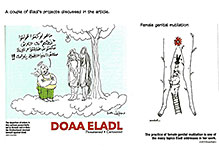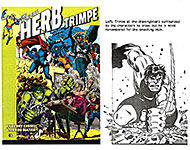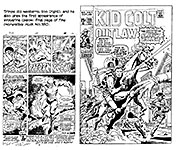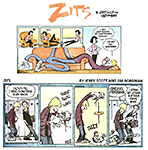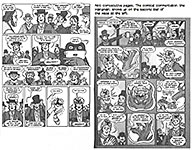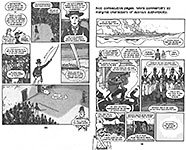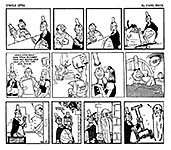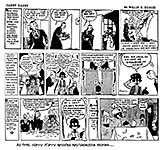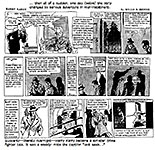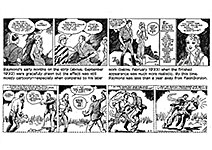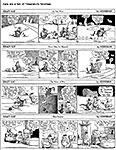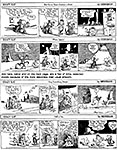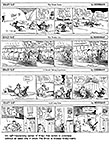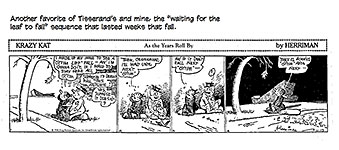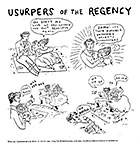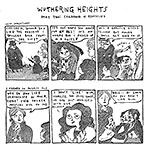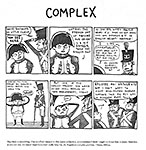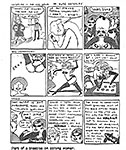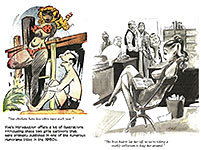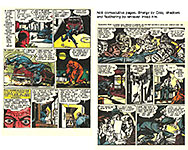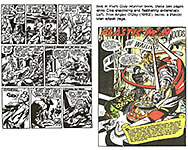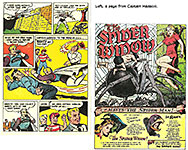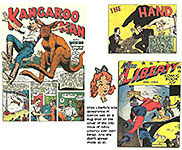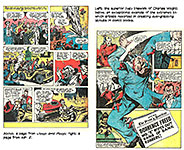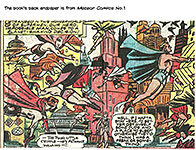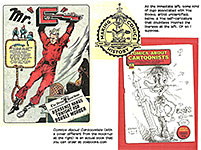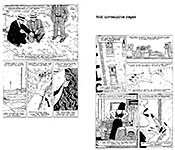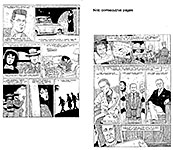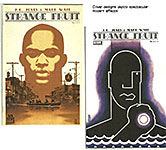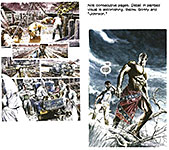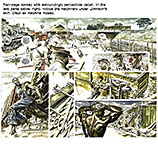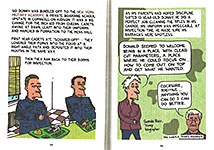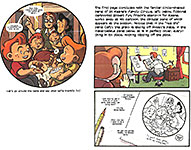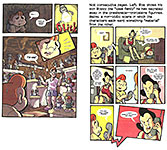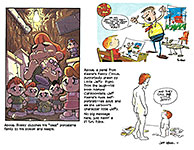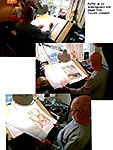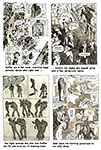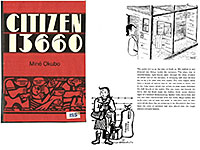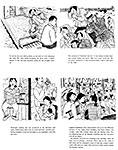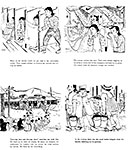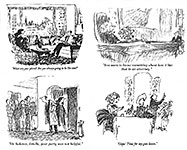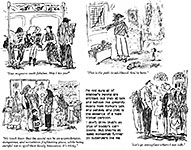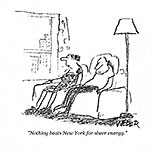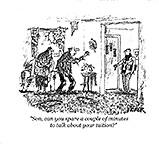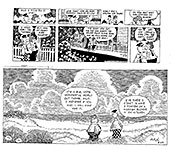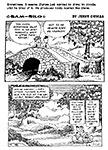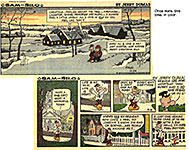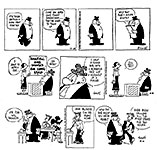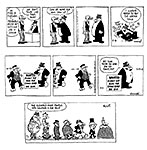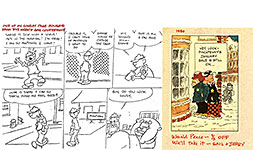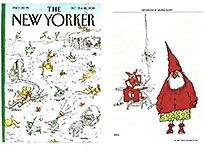 |
|||||||||||||||||||||||||||||||||||||||||||||||||||||||
Opus 361 (December 16, 2016). The date you just
read is the posting date, about 2-3 days after I finished writing this colyum
of trifling languor, indifferent whimsy and lasting trivolity. This
introductory effusion, however—the paragraph now under your very
eyeballs—includes our own anyule greeting.
And now, here’s
what’s here, in order, by department—:
JUST ANOTHER LAST WORD ON THE ELECTION Hallelujah by Leonard Cohen and Kate McKinnon on SNL NOUS R US Lewis’ March: Book Three Wins NBA for Young People’s Lit Entertainment Weekly’s Validation of Comics Last Gasp’s Last Gasp DeFalco To Write Reggie Book for Archie Playboy Continues to Fail 24-Hour Post-Election Turnaround at South Park Magazines That Jumped the Gun with Hillary Win? Resist! Another Sign of Trumpery Times Charlie Hebdo Goes to Germany Zunar Keeps On Turkey Suppression of Free Speech and Cartoonist Odds & Addenda Image Two-bit Books Barney Google Back Again Bob Dylan and Muhammad Ali Nobels
KRAZY BIOGRAPHY ARRIVES
FUNNYBOOK FAN FARE Reviews of First Issues of—: Frank Cho’s Skybourne Terry Moore’s Motor Girl Second Looks at—: Moonshine Cage Shipwreck Betty & Veronica Also—: Resident Alien 3 Lady Killer 3 Kill or Be Killed 3/4 Renato Jones: The One % 5 Sex 32 Prez ends in Catwoman Election Night No.1
EDITOONERY Postponed until Next Time, but—: Political Magazine Covers Barry Blitt All Over
THE FROTH ESTATE Trump’s Conflict of Interest: Get Over It The Trumpet Lied 560 Times
ACCRETION OF INTENTION DEPARTMENT Review of—: Stuff They Wouldn’t Print (2010) The Editorial Cartoons of Lee Judge
RANCID RAVES GALLERY 40TH Anniversary Cartoons at In These Times Telnaes Wardrobe Fanboy Head Exploding Bracket
NEWSPAPER COMICS PAGE VIGIL Interesting Happenings in the Funnies Brad and Toni’s Wedding
CIVILIZATION’S LAST OUTPOST The Bundys and the Sioux
XMAS SHOPPING LIST Reviews of Books Your Spouse Can Buy You for Christmas—: She Changed Comics: Untold Story of Women Who Changed Free Expression in Comics The Incredible Herb Trimpe Extra Cheesy Zits Alamo All-Stars: A Texas Tale The Lost work of Will Eisner Tim Tyler’s Luck: 1934 (Alex Raymond’s debut) Krazy Kat: 1934 Step Aside, Pops Jack Cole’s Deadly Horror
BOOK REVIEW Super Weird Heroes: Outrageous But Real!
GRAPHIC NOVEL REVIEWS Black Dahlia (Rick Geary) Strange Fruit Trump: A Graphic Biography (Ted Rall) The Fun Family (satire of Bil Keane’s The Family Circus) The Funnies (prose novel) Cousin Joseph (Feiffer) Citizen 13660 (Japanese Internment, 1942-45)
COLLECTORS’ CORNICHE Painted Portrait of Charles M. Schulz, c. 1999
ONWARD, THE SPREADING PUNDITRY Why I Don’t Fear the Forthcoming Trumpery Administration PASSIN’ THROUGH Robert Webber Jerry Dumas
A George Booth Christmas Annual Report: November 2015 - October 2016
QUOTE OF THE MONTH If Not of A Lifetime “Goddamn it, you’ve got to be kind.”—Kurt Vonnegut
Our Motto: It takes all kinds. Live and let live. Wear glasses if you need ’em. But it’s hard to live by this axiom in the Age of Tea Baggers, so we’ve added another motto:. Seven days without comics makes one weak. (You can’t have too many mottos.)
And our customary reminder: don’t forget to activate the “Bathroom Button” by clicking on the “print friendly version” so you can print off a copy of just this installment for reading later, at your leisure while enthroned. Without further adieu, then, here we go—:
JUST ANOTHER LAST WORD ON THE ELECTION The best by far reaction and response to Trump’s victory took place on “Saturday Night Live” on November 12, the first post-election broadcast, when Kate McKinnon sat at the piano in what I take to be her Hillary persona and played and sang: I heard there was a secret chord That David played and it pleased the Lord. But you don’t really care for music, do ya? Well, it goes like this— The fourth, the fifth, the minor fall and the major lift, The baffled king composing Hallelujah (five times).
Maybe I’ve been here before. I’ve seen this room and walked the floor. I used to live alone before I knew ya. I’ve seen your flag on the marble arch And love is not a victory march— It’s a cold and it’s a broken Hallelujah (five times). I did my best; it wasn’t much. I couldn’t feel so I tried to touch. I told the truth: I didn’t come to fool ya, And even though it all went wrong, I’ll stand before the Lord of song with nothing on my tongue but Hallelujah (seven or eight times).
Then she stopped playing and turned to the camera and said, mildly defiant: “I’m not giving up, and neither should you.”
Until her closing remark, it could be a lament. And it was. But it was more.
And it made me weep.
Ironically, Leonard Cohen, the writer of these lyrics, “Hallelujah,” had just died, November 7, the day before Election Day.
NOUS R US Some of All the News That Gives Us Fits
LEWIS’ MARCH WINS “This is unreal!” shouted Congressman John Lewis as he and his co-creators writer Andrew Aydin and artist Nate Powell accepted the 2016 National Book Award (NBA) for Young People’s Literature for March: Book Three (Top Shelf, 2016). The title is the third in a graphic memoir that chronicles the civil rights movement from the bombing of the 16th Street Baptist Church in Birmingham, Alabama, on September 15, 1963, to the passing of the Voting Rights Act on August 6, 1965. But—an award for Young People’s Literature? Why Young People? Is it because graphic novels are glorified comic books, and comic books are for young people? Probably. But I don’t think the March trilogy was written expressly for young people. I think it was written for everyone, regardless of age. I know: a carping criticism. Don’t look gift horseflesh in the maw. Accept your fate. But Lewis didn’t. He didn’t accept his fate. “There were very few books in our home,” Lewis recalled in accepting the award. He also told of going to his public library to get a library card, only to be told that libraries were “for whites.” Despite this, Lewis was still encouraged by his elders to “Read my child, read,” he said. Aydin, digital director and policy adviser for the Congressman, as well the March trilogy’s co-author, reminded the audience that the “story of the movement must be told.” Lewis, who as a young man was directly involved with the Freedom Vote in 1963 in Mississippi, was convinced to tell his story in a graphic format by Aydin. A big fan of comic books, Aydin proclaimed at the close of his acceptance, “Prejudice against comic books must be buried once and for all.” Hear, hear. Two days later, back in Nashville, Tennessee, which Lewis calls the first city he ever lived in, the Congressman was interviewed by Margaret Renkl on behalf of the Nashville Public Library Literary Award, which Lewis was on hand to receive the next day.
Margaret Renkl: Back in your student days, when you were being arrested repeatedly for working to integrate restaurants and movie theaters and the rest of daily life here, what would you have said if someone had told you that one day you’d be back in Nashville to accept a prestigious award for your work as an author? John Lewis: I would have said, “You’re crazy. You’re out of your mind. You don’t know what you’re talking about.” I feel more than lucky—I feel blessed to come back here. I’m honored, I’m gratified, I’m pleased. Asked about how he thinks the Black Lives Matter organizers feel about his generation of leaders, Lewis said: “I think the Black Lives Matters generation tends to admire and embrace what we did. I have had the opportunity to sit down and meet in Atlanta—and also in Washington—with many of the young people, and I tell them all the time, ‘Read the literature, read the papers and books and speeches from that period. You could learn something.’ And I tell them that we never became bitter. We never became hostile. We believed in the way of peace, the way of love—we believed in the philosophy and the discipline of nonviolence. I say, ‘You can learn something from the 1960s.’ And that’s what I tell them each and every time I meet with some of them.” Does he have any advice for American children? “Yes. I would say, ‘Children, read. Read everything. Learn as much as you can learn. Study. Be kind. Be bold. Be courageous. And just go for it.’ As I write in the book, my mother and father and grandparents and others said, ‘Don’t get in trouble. Don’t get in the way.’ I was inspired to get in trouble, and I got in what I call good trouble, necessary trouble. People like Rosa Parks and Dr. King and Jim Lawson and others—and being in Nashville—helped mold and shape me, and I have not looked back since.” Margaret Renkl: In the March trilogy, the story of your history is framed and punctuated throughout with scenes from your experiences on January 20, 2009—the day of Barack Obama’s first inauguration—and it includes a note signed by President Obama: “Because of you, John.” What are you thinking as you watch his presidency come to an end after eight years? John Lewis: It’s difficult to see it come to a close because I think President Barack Obama has injected something rare and meaningful into America, and it’s going to be missed. I see him from time to time; I listen to him by way of radio, TV; I read about him and each time he seems to be hopeful and optimistic. And that’s what we need more than ever before. I think he’s been good for America. He’s been good for the world community. On one occasion, when he was running for reelection, I said, ‘Mr. President, if you were running for reelection in Europe, you wouldn’t have to campaign. You’d win by a landslide.’ I’ve traveled to different parts [of Europe], and the people there love him.” Reported by Rocco Staino at slj.com
THE ULTIMATE VALIDATION OF COMIC BOOKS Now that the movie business has established the cultural worth of comic books for everyone except the National Book Awards, Entertainment Weekly has begun to pay attention to more than just the summer extravaganza in San Diego. In the December 2 issue (with a cover story about the next Star Wars movie), a new funnybook by “two of the most exciting comic-book creators, Scott Snyder and Jeff Lemire” is fulsomely plugged. A.D., “a compelling mix of comics, art and storytelling,” is a “beautiful new series that explores a world in which death has been eliminated.” Another title in a lengthening roster of good comics—well drawn and well told in a blend of words and pictures—on mature (i.e., thoughtful) themes. And comics even intruded in EW’s year-end “Best of 2016" issue, December 16/23. “Entertainer of the Year” is Ryan Reynolds —for his portrayal of smart-ass potty-mouth Deadpool, no less. And Benedict Cumberbatch is among the other top twelve “entertainers of the year” for his Dr. Strange as well as Sherlock Holmes. Among
the year’s best movies, “Batman vs Superman: Dawn of Justice” is listed because
of the way breakout actress Gal Gadot plays Wonder Woman. And “Captain
America: Civil War” is tenth in the top ten movies of 2016. This commemorating issue even lists the Best Comic Book series of the year—Black Panther (Best New Series), Bitch Planet (Best Returning) DC Comics Rebirth series (Best Reboot), Monstress (Best Ongoing), and Goldie Vance (Best All-Ages). But there’s no “best graphic novel”category. Finally, in reporting the reading recommended by various entertainment dignitaries (Emma Watson, J.K. Rowling, Stephen King and Kerry Washington among others), the magazine cites Sarah Jessica Parker, who recommends Tintin in Tibet by Herge. But I don’t want to give up on EW’s best of the year without pausing to note that the magazine recorded the “most bizarre auction item”—Truman Capote’s cremains, which, “ensconced in a wooden Japanese box, sold for $43,750.” Ewww. Further evidence of EW’s allegiance with the comic book world, subscription renewal forms that arrived last month offered a bonus for subscribing by December 3—superhero t-shirts featuring (your choice) the Flash, Batman, Superman, Wonder Woman or Super Friends. Talk about uptown: we’re there! Stick that in your ass, National Book Awarders.
LAST GASP’S LAST GASP (Couldn’t resist that headline.) According to Milton Gieppe at ICv2, “Last Gasp has announced that it is closing down its distribution business, which has wholesaled comics, graphic novels, art books, and other publications for 47 years. The distribution business rose out of Last Gasp’s roots as a publisher of underground comics, which were sold through a network of bookstores, head shops, record stores, and eventually comic stores. Last Gasp used that network to sell not only its own comics, but those of competing publishers, and added to its mix books and occasionally magazines that fit the same audience.” The company will now focus exclusively on its publishing endeavors “for which it has many new titles planned for 2017.” Meanwhile, my guess is that we should keep a sharp eye out for a bargain-hunter’s sell-off of the publisher’s remaining inventory.
SURPRISE: SUPERHEROIC REGGIE AT ARCHIE COMICS At CBR, Jeffrey Renaud reminds us that “as a writer and editor, industry legend Tom DeFalco has told stories with heavyweight heroes ranging from the Amazing Spider-Man and the Fantastic Four to G.I. Joe and the Transformers. So when he calls Reggie Mantle a ‘sinister super-villain,’ you might want to pay attention.” What prompts this cautionary note is that DeFalco is going to be writing a new on-going series at Archie Comics—namely, Reggie and Me, about Archie’s presumed rival. The first issue hit the stands on December 7, illustrated by Sandy Jarrell, Kelly Fitzpartrick, and Jack Morelli. DeFalco started his career at Archie, so he’ll be coming “home” in some sense. Renaud asked him several impertinent questions about the new Reggie book, and DeFalco responded in kind. About Reggie, DeFalco said: “Classic Reggie was a prankster, but he was always rather harmless. He was also one of Archie’s friends, and a member of the gang. The current Reggie is an outsider. Yes, the other guys want to be like him and the girls want to be with him, but he is no longer a member of the gang.” Renaud: You say he’s one of your favorite characters. You admit that he’s been called a self-aggrandizing egotist, a sinister super-villain, a merciless monster and worse. So — what’s to love? DeFalco: What’s not to love? He drives the best cars and throws the wildest parties. He is also the closest thing Riverdale has to a supervillain and everyone loves a great villain. Renaud: Is Reggie Mantle misunderstood? DeFalco: Absolutely! A lot of people assume he has some redeeming characteristics. [Laughs] Renaud: Can you confirm today that the ‘me’ of Reggie and Me is in fact Reggie’s dog, Vader? DeFalco: I could, but why spoil the surprise? Renaud: Will you be telling done-in-one stories in Reggie and Me or will the stories be longer arcs? DeFalco: I will be doing both. Every individual issue will be a done-in-one, but the stories will build upon each other to form larger arcs. I never make life easy for myself. Renaud: What can you tell us about the first story that you have planned? DeFalco: Reggie throws a party and things go sour for everyone… except Reg. Also, we learn the not-so-secret origin of Vader.
PLAYBOY CONTINUES TO FAIL The December
issue is out, and it actually has two cartoons in it. Simple scrawls, both of
them, scarcely in the same I got my renewal notice last week. I sent it back, annotated: “Not until you start publishing good cartoons again.”
MAJOR KERFUFFLE AT SOUTH PARK WHEN HILLARY LOSES “South Park” famously creates each episode within a week, as chronicled in the 2011 tv documentary “Six Days to Air.” In 2008, as Michael Cavna reports at Washington Post Comic Riffs, the show impressively turned around the episode “About Last Night .?.?.” to react to Barack Obama’s first presidential win, less than 24 hours after it was official. And this year, they did it again. In what Cavna thinks might be “South Park’s” best single-day rewrite ever, the Clintons and the show’s Colorado denizens absorb the nation’s presidential results just hours after real-life Hillary Clinton conceded. Wednesday night’s episode, as originally written, was to focus on Bill Clinton’s becoming the first First Gentleman. But Donald Trump’s poll-defying victory forced creators Trey Parker and Matt Stone to scramble at the 11th hour, changing the episode, retitled “Oh, Jeez,” to reflect at least half the nation’s blindsided surprise and electoral mourning. In the show’s trademark style of paper-cut animation (so crisply digitally rendered), mouths are agape all over South Park, as the Marsh family and their neighbors sit in awkward and dumbstruck silence, as it witnessing a national car crash. At one point, papa Randy Marsh declares: “A woman can be anything — except for president.” Three characters who remain in full-action mode, though, are Hillary and Bill Clinton and the show’s Trump avatar during the season-long election arc, schoolteacher Mr. Garrison. Two true villains in all this, according to “South Park,” are sexism and the mind-numbing allure of nostalgia. Hillary ostensibly drafts super-troll Gerald for an international plot to stop the world’s most damaging online-leaks fallout. Meanwhile, her husband drafts a fellow Bill, Cosby, into his “gentlemen’s club,” spreading the message that women are growing sick of male misbehavior (and worse) and will eventually topple the patriarchy, rendering men (mostly) irrelevant and sentencing them to subterranean confinement.
SNAFU BY JUMPING THE GUN? Even after Donald Trump was actually elected on November 8, reported Alex Johnson at NBC News, Newsweek published 125,000 copies of a $10.99 commemorative magazine with Hillary’s picture on the cover and the headline "Madam President." Were they simply anticipating what would happen (according to all the polls)?—as the Chicago Tribune famously did in the 1948 Election when it decided that Tom Dewey won and headlined the post-election issue accordingly; and when Harry Truman won, he held that edition of the newspaper aloft with a huge grin on his face. The “Madam President” copies were quickly recalled — but hundreds of these “collectors’ dream” copies are still being offered for sale in online markets, “for prices as low as 99 cents to as high as $9,995. NBC News found 387 offers for the recalled issue Wednesday evening just on eBay.” The publisher maintains that only 17 copies were actually sold before all the rest were recalled, bringing into serious question the authenticity of many of those online offers. Newsweek itself distanced itself from the "Madam President" edition when news of it emerged even before Election Day, saying on Twitter that commemorative covers were produced for both Clinton and Trump "by a Newsweek licensee, Topix Media, and not by Newsweek." But whoever is responsible—and even if the Clinton cover story wasn’t actually a prognosticating gamble gone awry like the Chicago Tribune’s 1948 laughable forecast—we get to enjoy two covers for two cover stories, knowing only one is accurate. Worth a chuckle. Pictures of the covers are on the other side of the $ubscribers Wall, where we also post some wag’s deployment of the New York Times masthead for a little cartoonish fun—cartoonish because the pictures explain the words in the headline. Good joke. And
we also have some wag’s deployment of the New York Times masthead for a
little cartoonish fun—cartoonish because the pictures explain the words in the
headline. Good joke. And
while we’re pondering this sort of two-faced prophesying, here are two by Daryl
Cagle, editoonist and head of a distribution syndicate for dozens of other
editoonists. At the top, we have Cagle’s first thoughts about the results fo
the Election; then, when Hillary didn’t win, he quickly revamped the cartoon,
switching heads for the second version just below the first. Said Cagle: “Hillary is a blue dragon now [slain Democrat]. I gave her dead ‘x-eyes’ replacing the bloody sword so that she wouldn’t have ‘blood coming out of her whatever.’ “I
had a lot of good company among my cartoonist colleagues,” he continues,
writing at his syndicate headquarters on the day after the Election, “—in fact,
we faced a bit of a crisis this morning as no cartoonists had drawn Trump Wins
cartoons in advance. But “I suspect that we’ll be in for four years of the same,” he concluded. “We’ll certainly see Trump hair placed on every imaginable monument and metaphor,” he concludes, accompanying the remark with another cartoon.
ANOTHER TRY AT FEMALE EMPOWERMENT FAILS Wonder Woman's less than two-month reign as a United Nations honorary ambassador ended December 16. According to Sebastien Malo at news.trust.org, plans had called for use of the character in an empowerment campaign for women and girls to fight for gender equality, especially to appeal to young people. But the plan “sparked heavy criticism that the choice sent the wrong messages.” (See Opus 359 for the story.) Dozens of U.N. employees protested on the day of the appointment. And nearly 45,000 people signed an online petition asking U.N. Secretary-General Ban Ki-moon to reconsider selection of the buxom character. "Although the original creators may have intended Wonder Woman to represent a strong and independent 'warrior' woman with a feminist message, the reality is that the character's current iteration is that of a large breasted, white woman of impossible proportions, scantily clad in a shimmery, thigh-baring body suit," the petition read. Release next year of a special-edition Wonder Woman comic book on the empowerment of women and girls, announced in October, is still planned, said DC Entertainment spokesperson Courtney Simmons.
ANOTHER SIGN OF THE TRUMPERY TIMES A couple of Spiegelmans are collaborating on an anthology of comics and illustrations “on the theme of political resistance to the forces of intolerance,” reports Gabe Friedman at jta.org. Entitled RESIST! and produced by Nadja Spiegelman, 29, daughter of the famous holocaust Maus man, Art, and his wife, Francoise Mouly, art editor of The New Yorker, the publication is “fervently anti-Trump.” A special issue of Gabe Fowler’s “quarterly tabloid comics anthology” Smoke Signal, 30,000 copies of which will be distributed for free in Washington, D.C., on Inauguration Day in January. More copies will be given away at women’s marches across the country in the days after. Submissions of cartoons and illustrations— including some from big names like Roz Chast — have exceeded Spiegelman fils’s expectations: 500 in the first week. ... While the initiating concept of the project was to give female voices an opportunity to react to the election of the Trumpet, some illustrations also tackle anti-Semitism, and the phrase “RESIST the normalization of fascism” appears at the top of the website’s “about” page. One
image references Trump’s promise to “drain the swamp” of political insiders in
Washington, showing Hitler’s face emerging at the bottom of the swamp as the
water is drained away. “We’ve clearly hit a nerve,” Spiegelman said. “There’s such a need that people have, especially artists, to find ways to begin to pick up a pen and fight against this. Now more than ever we do need to use our voices and make them as loud as possible.” The concept originated with Fowler, who runs the Desert Island comics store in Brooklyn, where he produces his quarterly comics publication. He decided to have an issue edited by women. He reached out to Mouly and asked her to head the project; she subsequently asked her daughter to help. At first, the idea was to accept only submissions from women and focus on women’s issues. The team has since broadened its scope: they are accepting submissions from men as well, but issues of female concern remain a dominant theme. Spiegelman said it was interesting to separate the submissions by gender — the female artists tended to include drawings of women, while the male artists tended to include an image of Trump. Spiegelman said she hasn’t received any of the online anti-Semitic abuse coursing through Twitter in recent months. But her mother received some hate mail after publishing a New Yorker cover that criticized Trump’s intention to build an impenetrable wall on the border with Mexico. [We’ve reproduced that cover in our Editoonery department.—RCH] Said Spiegelman: “She forwarded it to the rest of the family, saying ‘Wow, I must be doing something right!’”
CHARLIE GOES ABROAD The first German edition of the French satirical newspaper Charlie Hebdo arrived on newsstands December 1, nearly two years after an attack on the publication’s headquarters in Paris killed top editors and cartoonists, ostensibly because they insulted Islam. The German edition is a response to significant German interest in Charlie Hebdo after the attack, editors told Charly Wilder at the New York Times. “It’s an experiment,” Gérard Biard, Charlie Hebdo’s editor in chief, who added that the paper had been the subject of numerous exhibitions, awards and news coverage in Germany since the attack on January 7, 2015. With an initial print run of 200,000, the new edition will be available across Germany every Thursday. It will consist mostly of translated material from the French version, but with some original content for its German readers. The first cover, Wilder reports, depicts a worn-out-looking Chancellor Angela Merkel lying on a hydraulic lift, with a caption saying that the embattled German carmaker Volkswagen “stands behind Merkel” and that “with a new exhaust pipe, she’ll be good to go for another four years.” The editor of the German edition, who uses the pseudonym Minka Schneider, said, “Germans feel particularly close to France and to Charlie Hebdo, and the debate about freedom of expression is very passionate here compared to other countries.” The first German issue, with 16 pages, features a four-page travel feature by the cartoonist Laurent Sourisseau, who uses the pen name Riss, depicting people he met across Germany and their thoughts on cultural heritage, national identity and the influx of hundreds of thousands of refugees, most of them Muslims, in the last several years. The reaction in the German news media has largely been positive, with a few exceptions. “I don’t believe that magazine will go over well in Germany,” said Martin Sonneborn, a former editor of Titanic, a satirical magazine, “because it has such a specifically French aspect and represents a very unique type of humor.” Charlie Hebdo’s brand of satire tends to be harsher and darker than German counterparts like Titanic and Eulenspiegel, said Wilder. The editors acknowledge the challenge of appealing to a German audience but said the timing of the new edition was opportune. “Germany is facing problems today that France already faced a few decades ago, like immigration and the banlieues,” Schneider said, referring to the heavily immigrant neighborhoods that ring many French cities. “So maybe learning something about French society can help the Germans, and humor is a good way to do this.” If Charlie Hebdo is less concerned about causing offense than are most German publications, that may be a good thing, Biard suggested. “In Germany, you hear about the Lügenpresse a lot,” he said, referring to a Nazi-era word meaning “lying press” that has been taken up in recent years by far-right protesters accusing the mainstream German news media of dishonesty. “I think no one can say to Charlie Hebdo that we’re all politically correct. We don’t think, ‘Oh you cannot say this in Germany, you cannot do this.’” “Everybody can be a subject in Charlie Hebdo,” Biard continued. “So we feel pretty free to have a look at German society.”
ZUNAR KEEPS STANDING UP The Malaysian cartoonist Zunar (Zulkiflee Anwar Ulhaque) can’t stay out of trouble. And even when he stays out of trouble he gets in trouble. When protesters disrupted an exhibition of his cartoons in late November, he was arrested. Not the protesters. Zunar was questioned by the police, detained for a day and informed that he was under investigation for producing cartoons that purportedly defamed Prime Minister Najib Razak. It was not the first time Zunar, who already faces nine charges of sedition and is barred from leaving the country, has courted trouble with his pen. His cartoons frequently target Najib, who is accused of taking millions of dollars from a state investment fund. Najib has faced widespread calls to resign, most recently at an anticorruption demonstration this month that drew tens of thousands in Kuala Lumpur, the capital. Zunar
was interviewed by Mike Ives of the New York Times just after the
incident. One of the things they talked about was the cartoon we’ve posted near
here. “It’s a self-portrait,” Zunar said. “In it, you see that three laws have been used against me. First is Sedition Act, second is Penal Code, third is Printing Presses and Publications Act. I was chained with these laws — hand, neck and leg. But if you go to my shirt, you can see my philosophies there. Among them are ‘I will keep drawing until the last drop of my ink’ and ‘How can I be neutral … even my pen has a stand.’ So this drawing shows that even though there’s a law to stop me, even though there’s a regulation to stop me, even though they tried to ban my books — actually, not tried, they already banned my book — I will keep drawing. That is why, without hands, I still use my mouth or my teeth to draw. This is to show the philosophy and determination to fulfill my duty as a cartoonist in Malaysia.” Zunar is expecting a tenth sedition charge, but even without it, he faces upward of 40 years as a maximum prison sentence if he’s convicted. How does he feel about it? “You have to understand this is a politically motivated charge; it’s got nothing to do with the law,” he said. “In Malaysia, it’s very, very difficult for us with politically motivated charges. You just need to look at what happened to the opposition leader’s case in Malaysia, Anwar Ibrahim. Even though he had strong evidence and witnesses, it was political. It will be very difficult for us to fix that. But this is a very important case for me to create awareness around the world about the state of freedom of expression and human rights in Malaysia. I’m going to face it.”
AND IT’S WORSE IN TURKEY In Turkey, President Recep Tayyip Erdogan has been cracking down lately on opposition throughout the country in the wake of a failed coup attempt several months ago. Tens of thousands of alleged coup collaborators have been jailed or fired from their jobs. “A failed coup is a great excuse to get rid of everyone Erdogan doesn’t like,” said editoonist/syndicate mogul Daryl Cagle in reporting the story—whether they were involved with the coup or not. “Virtually all of the media outlets that have been critical of him have been closed down. The only opposition paper left, Cumhuriyet, was raided last week with their editors, their top writers and their editorial cartoonist thrown in jail.” The
cartoons of Musa Kart have enraged Erdogan for years. Erdogan tried to
put Kart in jail for nine years for the 2014 cartoon (seen on the left in our
visual aid) that depicts a money laundering scandal as a hologram of Erdogan
looks the other way. “How will they explain this to the world? I am being taken into custody for drawing cartoons. I’ve been trying for years to turn what we’re living through in this country into cartoons. Now I feel like I’m living in one.” A 2005 cartoon (on the right in our exhibit) shows Erdogan entangled in strings. Kart was tried and sentenced to prison, “but his penalty was reduced to a fine, and the courts later dismissed the fine,” Cagle said. Hundreds of protesters camped overnight at the Istanbul headquarters of Cumhuriyet in support of the paper as the last symbol of freedom of the press. About the closing of news outlets, Christophe Deloire, secretary-general of Reports Without Borders, said: “Cumhuriyet is once again the target of persecution, another 15 media have been closed and there is hardly anyone left to cover this. ... If turkey does not stop using the state of ermergency to kill off media freedom, it will soon be too late. At this rate, media pluralism will be a distant memory before long. Are people sufficiently aware of the dramatic change taking place in this country, where no media outlet seems to be safe from this never-ending purge?”
Cagle, whose syndicate distributes editoons by cartoonists from all over the world, said cartoonists everywhere are sharing drawings in support of a free press. Here, to conclude this report, is one by India’s Paresh Nath, one of Cagle’s roster.
ODDS & ADDENDA Image Comics will celebrate 25 years as a comic book publisher next year, and it’s giving its fans a little gift, reports George Gene Gustines at the New York Times. February issues of The Walking Dead, Invincible, and Outcast, each written by Robert Kirkman, will cost only a measly two bits, just 25 cents (25 years; 25 cents). “The stories in these issues will be a good jumping on point for readers” Gustines said: “The Walking Dead No.163 follows the conclusion of the Whisperer War; Invincible No.133 begins ‘The End of All Things,’ a 12-part story that will conclude the superhero series; and Outcast No.25 will introduce characters to the series about demonic possession.” Barney
Google, who was written out of his own comic strip (although not out of the
title) years ago after Fred Bob Dylan didn’t make it to Sweden to pick up his Nobel Prize for Literature: ol’ sourpuss stayed home and stewed in his continually reinvented mysteriousness. But the whole Dylan-Nobel fiasco prompted a Faux News enterprise to post this headline and story: Muhammad Ali Posthumously Awarded 2016 Nobel Prize for Literature as author of the immortal lines “Float like a butterfly, sting like a bee.” I’m going to look into Dylan’s poetry a little over the next few weeks; report next time.
Fascinating Footnit. Much of the news retailed in the foregoing segment is culled from articles eventually indexed at rpi.edu/~bulloj/comxbib.html, the Comics Research Bibliography, maintained by Michael Rhode and John Bullough, which covers comic books, comic strips, animation, caricature, cartoons, bandes dessinees and related topics. It also provides links to numerous other sites that delve deeply into cartooning topics. For even more comics news, consult these four other sites: Mark Evanier’s povonline.com, Alan Gardner’s DailyCartoonist.com, Tom Spurgeon’s comicsreporter.com, and Michael Cavna at voices.washingtonpost.com./comic-riffs . For delving into the history of our beloved medium, you can’t go wrong by visiting Allan Holtz’s strippersguide.blogspot.com, where Allan regularly posts rare findings from his forays into the vast reaches of newspaper microfilm files hither and yon.
FURTHER ADO “If you cannot teach me to fly, teach me to sing.”—J.M. Barrie
THAT KRAZY BIOGRAPHY OF THE KAT’S KREATOR The long-anticipated biography of George Herriman, creator of the comic strip masterpiece Krazy Kat, is now awaiting your purchase on the shelves of the nation’s bookstores. Said Doug MacCash at NOLA.com Times Picayune, “Krazy: A Life in Black and White, the biography of the Crescent City-born newspaper cartoonist is an absorbing study of a genius with a secret. ... As New Orleans author Michael Tisserand deftly points out in his 549-page volume, the illogic of Herriman's ink-on-paper drawings mirror the absurdity of the racial divide in early 20th-century America.” Herriman’s secret, Tisserand says, is that he was black passing for white. MacCash continues—: After 10 years of scouring microfilm archives, yellowed newspapers and public records, Tisserand has pieced together Herriman's journey from his humble birth in the Treme neighborhood to heights of fame in Jazz-era New York and Los Angeles. Like a snake handler, Tisserand uncoils the confusing racial politics of New Orleans in the Jim Crow era, where the descendants of slaves and the descendants of so-called free people of color suffered segregation, discrimination and violence at the hands of the white population. As Tisserand explains, when Herriman was 10 years old, his parents fled the South for a new beginning in California, where personal reinvention was possible. Tisserand writes, "Herriman was a black man born in New Orleans." But upon reaching the Pacific, Herriman's parents "had obscured their identity and 'passed' for white." Had they not done so, Tisserand points out, the creator of the immeasurably influential Krazy Kat cartoon could never have received the classical education that he did, found work in major American newspapers, or bought a home in the Hollywood Hills, owing to universal racism. ... About midway through the book Tisserand delightedly introduces Herriman's masterpiece, a blithely bewildered black cat that is routinely abused by a brick-throwing white mouse. More than a century after his first appearance, Krazy Kat remains an enigma. "It's in Krazy's language that Herriman achieved what I think he was going for more than anything else," Tisserand said, "which is a sort of depiction of the entire rude, wonderful American character. It all mixes together in the language; one sentence can have German, French, Creole, Yiddish, you know, highbrow English, lowbrow English, and newspaperman slang, all jumbled together." Herriman's Krazy Kat strip, which appeared from coast to coast, allowed him to subtly comment on the superficiality of race, as the animal characters occasionally swap colors. ... Herriman was much beloved by his fellow cartoonists, intellectuals, and modern artists, but, Tisserand points out, his cartoon was always near the bottom of reader popularity polls. Its survival for three decades in the cutthroat early 20th-century newspaper business is as much a mystery as the goings-on in the strip itself. But, like a true artist, Herriman never backed away from his peculiar vision. "His work is unflinchingly uncompromising," Tisserand said. "He never seemed capable of doing anything less than bringing everything he had to the work, whether it's a literary allusion that most readers wouldn't catch or whether it's a visual allusion to a Navajo rug. He would do what he wanted, even if he knew, 'Boy, readers are not going to connect with this.'" Bravo to Tisserand for helping us connect. It's an amazing accomplishment to uncover so much information about a cartoon that the public has largely forgotten, in a style that's hard to describe, by a man that needed to keep his background in shadow. Speaking of Herriman's paradoxical legacy, Tisserand said: "I think he succeeded in creating a comic strip that reflected the way he viewed the world. It's delightful and sad and filled with unconquerable love and lots of bricks to the head." The HarperCollins hardback with a 16-page photo section went on sale December 6 for $35. Below, find an excerpt from the book that illuminates Herriman's influence on contemporary comics (in italics): No book collections of the strip Krazy Kat were published in Herriman's lifetime. By the time of his death, most comics pages had been discarded, or were disintegrating in garages and basements across the nation. Herriman's originals piled up at King Features, where young cartoonist Mort Walker once noticed that they were being used to sop up water leaks. Yet when one influential fan heard the news of Herriman's death, he determined that Krazy Kat would not be forgotten. Poet E. E. Cummings contacted his publisher, Henry Holt and Company, to propose that he collect and edit a volume of Krazy Kat comics, as well as write the introduction. [Social and literary critic] Gilbert Seldes was delighted to hear the news. "I am extraordinarily glad that you are going to do this," Seldes wrote to Cummings in the fall. "May I place at your disposal my ancient and incomplete collection of these masterpieces, and give you also whatever clerical or other assistance I can." The next year [1946], Henry Holt published Cummings' Krazy Kat, announcing that the comic strip "had been away from the papers for some time now," and that it was "something for Americans to be proud of." Cummings' book featured 168 strips, each selected by the poet. In his introduction, he described a "meteoric burlesk melodrama, born of the immemorial adage love will find a way." Cummings wrote of Krazy as a "humbly poetic, gently clownlike, supremely innocent, and illimitably affectionate creature," understood by Officer Pupp and Ignatz no more than the "mythical denizens of a two-dimensional realm understand some three-dimensional intruder." Cummings added new interpretations to Herriman's work, likening Krazy to the democracy's "spiritual values of wisdom, love, and joy" and Pupp and Ignatz to "those red-brown-and-blackshirted Puritans." With that, he joined would become a large chorus of writers, artists and academics seeking to limn the mysterious devotions of Krazy, Ignatz and Pupp. Cummings' anthology, while not a commercial success, became a coveted treasure for fans [I found my copy in a used bookstore in Richmond, Virginia, a generation ago; it was a fond early acquisition in reprint tomes that has since grown to fill a basement—RCH], and its influence ran deep. Most significantly, Cummings' book fell into the hands of a young Midwestern cartoonist, just returned from military service. "After World War II, I began to study the Krazy Kat strip for the first time, for during my younger years I never had the opportunity to see a newspaper that carried it," recalled Charles Schulz. "A book collection of Krazy Kat was published sometime in the late 1940s, which did much to inspire me to create a feature that went beyond the mere actions of ordinary children." In Peanuts, Schulz drew deeply from Herriman's themes of love and loss, and sin and guilt. He created a world as devoid of adults as Coconino County was devoid of humans. Whether by intent or coincidence, there even were direct borrowings. Cummings' collection included a series, originally drawn in 1934, showing Krazy, Ignatz and Pupp seated on a log, patiently waiting for the last "ottim liff" to fall. [See the review of the IDW reprint volume at Xmas Shopping List down scroll.—RCH] Schulz revisited this storyline frequently, drawing a leaf hanging onto a branch for dear life, or circling in mid-air for one last fling before the rake. In later comics, Schulz even wrote a series of gags in which a school building tosses a brick. Of all of Schulz's storylines, Lucy's relentless, obsessive football prank most suggested Ignatz and his brick. In fact, a Krazy Kat series, first published in 1932, shows Ignatz tying a string on a football, and then pulling it away when Pupp runs to kick it. Pupp, like Charlie Brown after him, lands squarely on his back. In a conversation with Mutts cartoonist Patrick McDonnell, Schulz acknowledged that even Herriman's Navajo-inspired zig-zag designs seemed to find their way onto Charlie Brown's iconic shirt. Schulz would honor his inspiration when he penned a drawing of Charlie Brown wandering onto the Coconino desert and getting beaned by Ignatz. Said Schultz: "I always thought if I could just do something as good as Krazy Kat, I would be happy. Krazy Kat was always my goal."
Fitnoot: The foregoing is a tantalizing look inside the book, which I haven’t otherwise seen, a situation that is already on its way to being remedied; I ordered the book several months ago. While I must wait until I have read the book before proclaiming a thorough-going opinion about it, a couple of intimations in the advance notices and interviews with Tisserand leave me a little testy (alas). First, I’m afraid that Tisserand is going to make too exact a connection between Herriman’s life and his comic strip: in the fashion of David Michaelis’ Schulz biography (which Tisserand admires), Tisserand may find the strip not an echo but a parallel of Herriman’s life. This is the kind of mistake made by people who are not intimately familiar with the cartooning medium and how cartoonists think—and Tisserand has no previous credentials in this area. Simply put, the art of cartooning is not autobiographical. And we must wait to see to what extent Tisserand understands this. Secondly, I’m leery of any argument that sees Krazy Kat as some sort of allegory about race in America. Many of the interviews and articles about the book have stressed this connection, but that may be a consequence of the “news” media’s proclivity for promulgating sensation, and while most of us have long ago realized that Herriman was of African descent, the general population, readers of the advance notices about the book, may not, and so the news media heaps up a “fresh” sensation to attract readers/consumers/viewers. To see Krazy Kat as a race tract does as much violence to the arts of cartooning as to see it as the cartoonist’s autobiography. In the last analysis (which I won’t perform until I’ve read the book), it’s a question of emphasis. It remains to be seen whether Tisserand has fallen into the error of this way or not. If he does—or if he successful navigates this, the trickiest part of his course, without making this mistake—I’ll tell you. I’m sure, however—based largely on the passages quoted above—that the book will be a rich trove of information about race in America during Herriman’s early life in New Orleans and in Los Angeles. For that alone, the book is to be applauded. In another article that surfaced lately among the flood of Krazy book pieces, Tisserand asks rhetorically why Mickey Mouse wears white gloves. Mickey and several other comic characters in the early years wore white gloves, and Tisserand theorizes that the minstrel shows of that era, still a vibrant part of America’s entertainment scene, inspired this wardrobe accessory. Many minstrel shows (perhaps most) featured white performers in blackface, imitating African American characters. And they wore white opera gloves—probably because wearing gloves made it unnecessary to blacken their hands. From this gloved kinship between comic strips and minstrelsy, Tisserand concludes that early strips were, in effect, offshoots of minstrel shows. A happy discovery, surely. But how accurate is it? There’s little question that minstrelsy influenced comic strips—and all American humor—for a time. Sometimes indelibly: that brick Ignatz throws at Krazy? It’s pure minstrel show—another version of the pie-in-the-face comic put-down stagecraft. And Herriman may have borrowed the maneuver from other strips, too: Mutt and Jeff often ended with Mutt hitting Jeff with a brick or some other equivalent of a custard pie. The white-gloved Mickey Mouse may have distant connections to minstrelsy (it’s such a great idea I’m ashamed to shortchange it), but I think there are other more mundane explanations. When Mickey first appeared in “Plane Crazy” and in other early performances, he isn’t wearing gloves. The gloves arrived (according to an online Guardian article) in “The Barn Dance” (1928) or “The Opry House” (1929). And here’s Walt Disney’s explanation for the gloves: “We didn't want him to have mouse hands, because he was supposed to be more human. So we gave him gloves. Five fingers looked like too much on such a little figure, so we took one away. That was just one less finger to animate.” “A very down-to-earth approach,” says Rolf Harris, who wrote the piece. “And if you put gloves on a cartoon character, you don't have to animate all those wrinkles and lines. Incidentally, there's a similar evolutionary path that can be traced to the emergence of Bugs Bunny's gloves in “A Wild Hare,” Tex Avery's l94O cartoon that gave us the classic phrase, 'What's Up Doc?'” Today’s lesson? We must be wary of poetic discoveries of this kind. Some are too good to be true, in the well-traveled phrase. And so, nit-picking curmudgeon that I am, I’ll be looking askance at any such poetry that may emerge in Tissserand’s book. Besides, Krazy, for all the vaudeville and minstrelsy in his/her comic strip, didn’t wear white gloves. Or any gloves at all. And Krazy was closer in time to vintage minstrelsy than Mickey.
KRAZY LATE-BREAKING: A day after typing the preceding paragraphs, I received my copy of Krazy. And while I’ve read only the first couple chapters and dipped in and out of some of the rest of the book, I’m happy to say that it appears that Tisserand has avoided the pitfalls I anticipated. He has done stupendous research in tracing the lives of the cartoonist’s family in New Orleans, linking the Herrimans to the free people of color power structure in the 19th century city. And it appears that he has done the same throughout the biography, digging up aspects of the cartoonist’s life that have, until now, been unknown—like Herriman’s ill-fated partnership with fellow cartoonist/artist Walt Kuhn to produce a movie in 1925. I’m sure there will be many more such nuggets of biography awaiting discovery throughout the book. I am disappointed, however, to see so little of Herriman’s comic strips in the book. In fact, there are no complete comic strips on display. None of Herriman’s stunning Sunday Krazy Kat strips. Not one complete daily strip. Individual panels from both Sundays and dailies are sprinkled throughout. But no complete strips. At first, I thought Tisserand was limited by some dictate from his publisher, some facet of copyright law that the publisher was afraid to confront. So rather than arrange costly permissions, Harper Collins opted for mere tokenism rather than full representation. And that brings us to a heartbreaking question: How can Tisserand pretend to examine and appreciate Herriman’s spectacular artistry without looking at some representative strips—complete strips, beginnings, middles and endings? The answer is, Tisserand makes no such pretense. His book is deliberately not about comic strip artistry. On the very first page of the book—the Author’s Note—he tells us of his self-imposed limitations: “the dimensions of this book do not allow for a full presentation of Herriman’s grand comics.” Just biography then? No, there’s a little more. “I have included panels from his works to illustrate certain ideas and to give at least a hint of their splendors.” And so on page 24, we have a panel in which Ignatz, sending a brick to Krazy’s head, exclaims: “You’re now a member of the fraternal brickhood of noble dornicks.” This alludes to Herriman’s father’s involvement with the Masons. Other
individual panels illustrate Herriman’s sensitivity about race and identity and
racial identity—Krazy looking at himself in the mirror, making black coffee
(“look unda the milk”), going to a beauty parlor and coming out blonde. This is sad because Herriman was so much a master of his medium and a pace-setting pioneer. Perhaps Tisserand will do better at a website (michaeltisserand.com), where he promises some of Herriman’s “grand comics” will be posted. (I couldn’t find it, though; maybe it’s not up yet; in the meantime, you could consult Harv’s Hindsight for November 2015, “Krazy Love,” where I offer the kind of analysis and appreciation I’d been hoping to find in Tisserand.) What remains, however—the 545 volume at hand—is a monument to Tisserand’s thoroughness in research and his dexterity in weaving so much of what he found into a fascinating tapestry of Herriman’s life. I look forward to finding more gems like this one: “Herriman began adding more decorations to his comics—especially the sun cross or wheel cross, a design common in southwestern Indian art. The symbol—a cross or X inside a circle—had special appeal to Herriman, for it also resembled the hobo symbol for a friendly household. ...”
FUNNYBOOK FAN FARE Four-color Frolics An admirable first issue must, above all else, contain such matter as will compel a reader to buy the second issue. At the same time, while provoking curiosity through mysteriousness, a good first issue must avoid being so mysterious as to be cryptic or incomprehensible. And, thirdly, it should introduce the title’s principals, preferably in a way that makes us care about them. Fourth, a first issue should include a complete “episode”—that is, something should happen, a crisis of some kind, which is resolved by the end of the issue, without, at the same time, detracting from the cliffhanger aspect of the effort that will compel us to buy the next issue. A completed episode displays decisive action or attitude, telling us that the book’s creators can manage their medium.
THE FIRST ISSUE of Frank Cho’s Skybourne opens with an unexplained puzzle and continues in the same mode until it ends. The puzzling first three pages take place 29 years ago; they depict a man in modern dress falling from great height, landing in a Chinese field with explosive force, then, prone in the hole his landing has created, opening his eyes and sighing. Nothing in the book explains this strange happening. If we hadn’t read early publicity about the title (see Opus 356 in August), we would not know, as Cho says then, that the falling man is “Thomas Skybourne, an immortal tired of his everlasting life, who goes on a search for a mystic weapon, Excalibur, that could kill him. In the opening sequence, Skybourne is seen falling from the sky (he jumped out of a plane without a parachute), his latest attempt at ending his life.” The
rest of the first issue, which takes place “today,” depicts the attempt of a
combative young woman named Grace Skybourne to obtain the storied sword
Excalibur. She has paid the asking price for the weapon, a medieval Arthurian
relic, but the owner is reneging on the deal. So in this issue’s central
completed episode, she battles him and his minions and takes it from him by
force, displaying her courage, resourcefulness and combat skills. “Force” for
Grace includes jamming her fist through bodies, skulls, buildings. Cho is the consummate comics storyteller. He tells his story here with minimum verbiage, the pages unfolding in almost continuous action sequences, all carefully worked out and exactingly depicted, varying camera distance and angle for the energy of visual variety. In Grace, he has created an intriguing character—strong, seemingly impervious to physical damage but, in the end, skewered to death. Since she appears to be the protagonist of the title, the book’s ending is the cliffhanger of all cliffhangers. And then there’s that cryptic opening sequence. In the second issue (of a scheduled five), we meet Thomas Skybourne (again): after his fall 29 years ago, he’s been living and working in a Chinese monastery, but Cardinal McSwiggin, an old friend and a power in the Catholic Church, comes to convince him to return to civilization to help battle an unknown tragedy looming on the horizon. Skybourne agrees and returns to Mountain Top, the headquarters, where he is tested by means of a physical encounter with a monstrous minotaur. Skybourne fails his test: he can’t get a blow in sideways. At the end of the book, the robed man from the first issue shows up again in a mountain cave where he keeps a dragon pursuant to his plan to take over the world.
There’s a good deal of talk in this issue as an exchange between McSwiggin and Skybourne fills in the many blanks left gaping in the first issue, and we see how skillful Cho is at constructing witty dialogue. We also witness a good amount of action and Cho’s catalogue of visually arresting sequences. Marcio Menyz is given cover credit as the colorist, and in this issue, we see why: he enhances Cho’s linear renditions with many delicately varied hues, modeling the characters exquisitely.
TERRY MORE is off and running again: Motor Girl No.1 is the launch of another graphic novel, which he’ll issue serially in parts before combining the whole thing into a single book like he did with Strangers in Paradise and ECHO and Rachel Rising. The first page introduces us to the rear end of Moore’s protagonist, Sam, a woman mechanic who operates an automobile junkyard, and her assistant, a talking gorilla named Mike. Seems right away to be an echo of Love and Rockets. But it’s not. The opening gambit is a completed episode in which we learn of Sam’s obsessions about the forthcoming end of the world and her wit. In the next completed episode in which Sam’s boss, an old dame named Libby, tells Sam someone wants to buy the yard, we learn that Sam is a vet who’s served three tours of duty, including imprisonment for a year in solitary confinement. And yet she continues to function—with wit and imagination, as we’ve seen. That night, a flying saucer lands nearby, the third completed episode. And when a little alien creature comes out of the saucer, it is squirted by an oil leak from the saucer. Sam fixes the leak, and the saucer and its inhabitants take off for outer space again. The
book ends as it began—with a focus on Sam’s butt. More than a little humor animates this issue, but we also get to know Sam and Mike well enough to want to see what they’ll do next. Moore tantalizes with his characterizations rather than with specific cliffhanger episodes. As usual, Moore’s drawings are clean and perfectly executed. They seem a little sketchier than previously—the line not as liquid and flowing— but maybe that’s just Mike’s fur. In any event, I’m looking forward to the next installment—not because I’m panting in suspense because of some dire situation Moore has left Sam and Mike in but because I enjoy humor and eccentric characters. Besides—what dire circumstance bodes in the would-be buyer of the junkyard? That’s a tantalizing enough question to bring me back.
SECOND LOOKS. Returning, now, for a second look at a few funnybooks we recently reviewed here, we come upon the second issue of Moonshine by Brian Azzarello and the inestimable Eduardo Risso. Still the same masterful visual storytelling, but the story has taken a turn from realism into horror fantasy when Pirlo, the big city mobster, runs into a werewolf in the woods, eating his human prey. I’m not much of a werewolf fan, but I’ll be back again and again just to watch Risso work his wonders. In the second issue of Cage, Genndy Tartakovsky continues to tell his story in an exaggerative Kurtzmanesque manner with Luke Cage running all issue from whoever clouted him at the end of No.1. The issue ends when he encounters a facsimile of Basil Wolverton’s Lena the Hyena. We’re on the verge of looney tunes here. This issue’s advertisement for the next issue, No.3, with a cover depicting several toothsome lovelies (displayed here in Opus 359), notes about those lovelies and that cover: “This cover has nothing to do with what’s inside.” Nice. The
second issue of Shipwreck by Warren Ellis and Phil Hester perpetuates Hester’s storytelling fireworks in layout and page design as well
as chipped and clipped rendering manner. The story itself persists in being a
puzzle with Dr. Jonathan Shipwright still wandering in search of some miscreant
who may have engineered the wreck of his spaceship. The first four pages are
silent as a new character dismembers a corpse so the birds—always hovering in
this comic book—can feed. On the last pages, we are treated to an insight into
how Ellis and Hester work: Ellis’ typewritten script for an early page in the
book is followed by Hester’s pencils and inks, showing how he interpreted
and/or deviated from Ellis’ scheme for the page. From the first page to the
last, this book is a genuine treat. The second Adam Hughes issue of Betty & Veronica has arrived, and it is as delicious as the first issue in Hughes’ limning of his heroines. Betty and Ronnie continue to battle to either save or condemn to corporate obscurity Pop’s coffee shop, but it’s the pictures that we buy this book for. Although it is slowly becoming apparent that Betty is the more buxom of the pair, Hughes is persuasively subtle: he seldom draws the girls in full figure, concentrating, instead, upon their faces, which are surpassingly beautiful. He and his colorist, Jose Villarrubia, persist in dimming the lights on every page. The usual bright intensity of the artwork in a comic book is dialed back, deliberately, in order to soften the visual impact of the colored drawings. This maneuver succeeds, but it also makes the pictures harder to see; I’m not sure that’s a good idea, especially with pictures as delightful as Hughes’.
BEYOND SECOND LOOKS: Peter Hogan’s Resident Alien is about the only book I buy solely for the story. Steve Parkhouse’s drawings are okay: they’re completely serviceable for storytelling. But they aren’t of the spectacular or engaging sort I most enjoy. (It’s linework that engages me, I have finally decided; and Parkhouse’s lines are quite pedestrian. They take us for the walk but do not, in addition, impress us with their ingenuity or visual appeal.) In the third issue of the latest story arc, the alien learns that two of the town’s inhabitants can “see” through his hypnotically conveyed human appearance for public consumption and can see him as he really is. We see him, too, and we know he’s an odd-looking duck. And one of those who sees him as he is warns him that “they” (someone terrestrial or extra-terrestrial) is coming for him. The third issue of Lady Killer 2 by Joelle Jones is not awash with as much bloodshed as we usually encounter in this title: our heroine, Josephine Schuller, investigates her assistant, the “clean-up man” Irving Reinhardt, who Josephine’s mother-in-law knew in the bad old days in World War II Germany, where Irving was a monstrous doctor, conning people out of their money and then killing them. Josephine’s would-be employer—the entity that directs her assassination assignments—disengages from her when they learn of her association with Reinhardt, who, it is revealed on the last page, has just “disposed” of Josephine’s husband’s boss, an altogether nasty and objectionable man. (That doesn’t justify killing him, of course; but it’s as close to justification as this title gets.) Poor Dylan, the assassin in Ed Brubaker and Sean Phillips’ Kill or Be Killed, commits another murder or two and sleeps with his roommate’s girlfriend, who likes Dylan better than Mason. But she wants “to talk” when Dylan comes home one night all banged up as a consequence of his latest encounter. The book’s scenes of New York streets at night with the snow falling are exquisite, thanks to colorist Elizabeth Breitweiser. The fifth and last (for now) issue of Kaare Kyle Andrews’ Renato Jones: The One % is out, and it is at least as fascinating an exercise in visual storytelling as the first issue—explosive episodic continuity, sudden flashbacks and wild page layouts, including a couple nearly blank spreads (for emphasis; it works). The villain is the “one percent” of the population—the really rich guys—who control everything. Renato Jones is the “freelancer” who attempts to right the world’s wrongs by killing the One%. But it’s not easy to discern his action or the plot amid Andrews’ zealous wildnesses in rampant opposition to the despised One% . He says he’ll be back with more in a second series of the title. Sex is now up to No.32, but it’s lost its appeal for me. The initiating notion, as I remember writer Joe Casey explaining it, has to do with how superheroes are, so to speak, victims of the sexual repression that accompanies being superpowered. That thread, alas, was never all that apparent, but it disappeared some issues ago, and now we have a hodge-podge of principal characters—so many, at least 19 of them, that the first page of every issue is devoted to listing and describing them because we’re likely to have forgotten them and their roles in the meandering plot—whose motives and actions are slyly alluded to each time they appear, but there’s never even a hint of resolution of the various dilemmas Casey has introduced. Wears me out just trying (unsuccessfully for the most part) to keep it all straight in my poor addled brain. As a backup story in Catwoman Election Night No.1, Mark Russell’s Prez fizzles out sadly but brilliantly. The Powers at DC have evidently decided that political satire is too risky to undertake in the Age of the Trumpet and a divided but passionate electorate (see Opus 357), so this is the last appearance of this happy frolic of a political satire funnybook. Herein, Russell takes on gun control (or, in this case, lack of it) and women’s reproductive rights, linking them for one of the niftiest wrap-ups you can imagine. The opening gun segment ends with the deaths of several open-carry advocates when the police can’t tell who the rogue shooter is. So much for the advisability of arming everyone: everyone armed is everyone a target. Later, Prez Beth is defeated in an attempt to control gun violence by limiting access to ammunition. “The Second Amendment,” she points out, “guarantees the right to bear arms, but it doesn’t say anything about ammunition. I mean, as long as we’re interpreting it exactly as it was written....,” she concludes satirically. But Russell gets in one final jab: birth control pills, which Beth’s Congress wants to outlaw, are finally permitted when they are shaped like bullets that can actually be fired from a gun rather than taken orally. Too bad there won’t be more of this caliber comedy in the future.
Quotes & Mots on Race in America “How have we come so far and yet have so far to go.”—Henry Lewis Gates, Jr. James Baldwin wrote in Harper’s magazine in 1961 that the questions that America faced about the death of segregation—a symbol of White America’s stranglehold—were “how long, how violent and how expensive the funeral is gong to be.”
EDITOONERY The Mock in Democracy IN ORDER TO
FOCUS THIS TIME on our Xmas Shopping List (down scroll), we’re
postponing our customary review of recent editorial cartoons until next time.
But we do offer a couple of editoonery comments on the election of Donalt Rump,
gasbag blowhard and self-important sex fiend —plus an all-prose diatribe at the
end of this opus in Onward, the Spreading Punditry, our own
gasbag department. Here, we merely gaze approvingly upon the post-election
cover of The New Yorker and a pair of Trumpet portraits published in Time just after the Trump Triumph. Bob Staake’s brickwall cover for the post-election issue of The New Yorker is discussed, briefly, at the magazine’s website, where the election of the Trumpet is viewed as a major collapse of Western Civilization: “ When we first received the results of the election, we felt as though we had hit a brick wall, full force. ‘The election of Donald Trump to the Presidency is nothing less than a tragedy for the American republic, a tragedy for the Constitution, and a triumph for the forces, at home and abroad, of nativism, authoritarianism, misogyny, and racism,’ editor David Remnick wrote in a piece posted shortly after the announcement. ‘The pathos—the disappointment at waking up on Wednesday morning and not finding a woman President-elect—is undeniable, and heartbreaking,’ added staff writer Amy Davidson. Our Web site is now continually updated with reactions like these, to the news of Trump’s victory. ‘To combat authoritarianism, to call out lies, to struggle honorably and fiercely in the name of American ideals—that is what is left to do. That is all there is to do,’ Remnick concluded. And so we must go on—with words and images such as this cover by Bob Staake for next week’s issue.” I’m more than a little less alarmed about the forthcoming Trump Regime. Yes, disaster stalks at every new naming of candidates for his Cabinet. But as you’ll see Under the Spreading Punditry, there is reason for hope.
AND SPEAKING OF THE NEW YORKER, the magazine’s favorite political cover artist, Barry Blitt, enjoyed a two-page spread in the issue dated the day before Election Day. Summoning an array of past presidential candidacies, Blitt shows that many of the Trumpet’s antics were anticipated in the machinations of others who paved the way. But Blitt’s triumph extended recently beyond the pages of The New Yorker. For Vanity Fair’s Holiday Issue, he did a huge montage of political and entertainment personages summarizing events of the year from Hillary and Bill Clinton to the Zika mosquito entitled “Last Call.” In the same issue of VF, Blitt illustrated the magazine’s 2016 Hall of Fame with a drawing of Trump and Hillary. And here, just at the elbow of your eye, are these components of this month’s Blittzkrieg.
I’m not a big fan of Blitt’s work, as you doubtless have noticed. But that’s a matter of taste and has little or nothing to do with quality. And the quality of his work is not in dispute. But I love linework in cartooning and other visual arts, and Blitt’s fragile line just doesn’t strike my fancy. Sorry. I must note, however, before casting him aside again, that he is not a caricaturist: his pictures of actual people lean in the direction of illustrated reality rather than cartoony exaggeration.
PERSIFLAGE AND FURBELOWS In a recent syndicated Bloomberg View column, Ramesh Ponnuru reported on a discussion between Cornel West, a rabid leftist, and Robert P. George, a outspoken conservative, on the topic of a liberal education. Said George at one point: “Our age is an age of the celebration and valorization of wealth, power, influence, status, and prestige. Those things are not bad in themselves, but they easily and all too often become the competition for leading an examined life.” The examined life, Ponnuru said, is what both George and West view as the purpose of a liberal arts education. “Its goal is to encourage critical reflection on the biggest questions; to lead us into an intellectual engagement that fulfills our nature as thinking beings; to help us achieve self-mastery; to enlarge our souls.”
THE FROTH ESTATE The Alleged “News” Institution THE PRESS AND THE PUNDIT CLASS are in a hot swivet about the Trumpet’s personal fortune and his globe girdling business empire which represents a blatant conflict of interest for the Prez-Elect. As it now stands, everything he says and does as President is likely to have repercussions affecting his wealth. The much-touted conflict, then, is embodied in a single question: how can we be sure the decisions he makes as Prez are made for the good of the U.S. and not just personal enrichment? The short answer: we can’t. Unless he sells off everything he owns, banks the money and lives off the interest. Unless he divests himself of his fortune. This solution is just a little idiotic. Americans supposedly elected a businessman because, among other things, the state of the country seemed to require businesslike administration. (We didn’t, actually, elect him Prez: by well over 2 million votes, we elected his opponent, Hillary Clinton. But we have a system for elections that is rigged—another of the checks and balances that are scattered throughout the Constitution—to prevent what the founders feared as “mob rule”; that is, the rule of the raw, illiterate and sheeplike majority in elections. So we’re stuck with the Trumpet.) Businessmen, as all of us in this capitalistic state know, are driven by a single motive—to make money, to turn a profit. Trump the businessman has already trumpeted that he expects to make a profit from his candidacy. Why not from his term of office as Prez? Of course he’ll use the Presidency to enrich himself. That’s what businessmen do. The Prez is not required by law to divest himself of his investments; the Presidency may be the only American elected office that is not encumbered by this requirement. But the populace nonetheless expects him to reduce the “appearance” of impropriety by turning his back on his business empire. Given the sprawling entangled nature of the Trumpet’s business interests, divestiture seems a terribly complex prospect. It is unlikely to be accomplished easily or quickly. Certainly not before he actually becomes Prez. We’ll be inaugurating a man with rampant conflicts of interest on January 20. And even if it were feasible to divest himself, is it reasonable to expect it? The so-called “blind trust” that many American political office-holders set up to immunize themselves from conflict of interest—letting some unknown third party run their businesses until they are no longer in office—doesn’t seem feasible either. Trump has been training his adult children to take over his business whenever he retires (or dies). To demand that he divest himself would result in divesting them, too, depriving them of their presumed inheritance. Is that fair? No. Do the mores of our nation demand that our presidents impoverish themselves before they can serve the country? Holy reason would agree: that’s both silly and impossible. And unreasonable. So for the sake of pragmatic fairness, we’re stuck with a businessman and his conflicts of interest as Prez. The plain sense solution to the problem is actually quite simple. Trump should make public all his business interests and connections so that everyone knows where conflicts of interest are possible. Then we should set up a special watch-dog bipartisan commission to keep a baleful eye on what Trump does as Prez and how it might affect his businesses. The commission can issue weekly or monthly—and certainly yearly—reports. And whenever Trump makes a presidential decision that enriches himself as a private businessman, we’ll know. And if Trump can convince us that the decisions he makes are also beneficial to the country, fine; if not, not. At least, we’ll know. And it is ignorance of conflicts of interest that most provoke us—the likelihood that some politician might enrich himself without our knowing it. We all know already that politicians get wealthier while in office. But it’d be nice to know how they accumulate all that, what favors they did to get it.
ONE OF THE FACT-CHECKING enterprises kept track of the Trumpet’s questionable utterances over the last couple years and determined that 560 of his statements were either outright lies or gross misrepresentations of the truth.
IN THIS MORNING’S PAPER, the Trumpet is quoted as saying he doesn’t need intelligence. We can tell.
IT WAS, OF COURSE, INEVITABLE. Donald Jerk Trump is Time magazine’s “Person of the Year,” that individual (group or idea), since the first one in 1927 (Charles Lindbergh), who has most influenced the events of the year, for good or ill. Not the good guy of the year; not the bad guy of the year. Gandhi made it once; so did Adolph Hitler. So did Wallis Simpson. Only a handful have made it twice. As a gauge of American influence on world events, all the doubles are U.S. presidents—FDR, Truman, Eisenhower, Nixon, Reagan, George W. Bush, and Obama. Most of the second appearances are due to the Person having been re-elected to the Presidency. This year, by gaucherie alone, the Trumpet wins. Time’s attitude is indicated in the headline next to Trump’s cover photo: “President of the Divided States of America.” I don’t think we’re as divided as all that, but if the “news” media and the everlasting gasbags keep saying it, it’ll undoubtedly happen. The
best photographic portrait of the Trumpet appears on the Table of Contents
page—where he is pictured in his customary “What me? How can I explain it”
pose, smirk on his face, hands open in a gesture of complete helplessness. This annual ritual issue is out a little early this year, seems to me. I remember reading the Person of the Year issue between Christmas and New Year’s, something to do in the interregnum. Lots of reading, as usual. Some nice features—a page of “firsts” and “lasts”: the first musician to get a Nobel Prize for literature; the last day (December 31) that the Carnegie Deli will be open for business in New York. A picture of the first time Trump appeared on a Time cover—June 16, 1989, when he was celebrated as a business mogul and playboy-about-town. Famous quotes—“Grab them by the pussy.” And Joe Klein concludes the issue with a column about the Obamas. Entitled “Amazing Grace,” it talks about the Obamas as a married couple with kids who have persisted in being a married couple with kids even in the glare of the world’s most glaring spotlight. No melodrama; no scandals. “He’ll be remembered for his eulogies,” Klein notes—the things he said about the senseless deaths that occurred during his tour. “He could convey a cathartic sadness and the potential for uplift in the face of tragedy. His most perfect moment came at the funeral of the Charleston, S.C., churchgoers who had been killed by a sick white man.” The shooter had already been forgiven by the families of the dead. “How to respond to that? Words couldn’t cover it, so he sang ‘Amazing Grace’—a moment of bravado, humility and passion entwined.” Even in remembering it, my eyes tear up. We will not to see his like again.
READ AND RELISH In it’s Holiday issue, Vanity Fair listed the Obamas in its 2016 Hall of Fame, saying: “Because as they prepare to fly into the sunset, we echo the cry of Bandon de Wilde at the end of ‘Shane’: ‘Come back!’ Barack Obama’s loping elegance, grace under pressure, pinpoint humor, and jedi dedication to reason, excellence and democratic values in the face of economic collapse in 2008, a racist scavenger hunt for his birth certificate, and eight years of conservative obstruction will acquire a storybook aura for presidential historians. Featuring a First Lady whose strength, passion, and oratorical power conferred honor on us all. Admit it, America: we lucked out with the Obamas. We can only hope that, post-Obamas, our luck hasn’t run out.”
ACCRETION OF INTENTION DEPARTMENT Books In Need of Good Reviews THE RANCID RAVES Book Grotto is littered, literally, with books we acquired with the intention of reviewing them. Alas, they’ve piled up over the years, and it has become increasingly apparent that we’ll never give most of them the kind of intensive examination they deserve. So rather than let the accretion be entirely in vain, we’ve started this new department wherein we’ll briefly describe these lost tomes by way of urging them upon you, focusing, this time, on—:
The Stuff They Wouldn’t Print: A Collection of Rejected Political Cartoons By Lee Judge; Foreword by Gary Larson 104 8x8-inch pages, b/w; 2010 Kansas City Star Books paperback, $3 or less at AddALL or some other book finder site JUDGE draws editoons for the Kansas City Star; last I heard, he’s no longer “on staff” because of insidious budget cuts, but his cartoons still appear in the Star and they pay him as a freelancer. Six years ago, he collected this bunch of his cartoons that didn’t make it past his editors. “Some,” Judge explains, “deserved to be killed and some didn’t.” The cartoons are arranged in chapters—Death, Illness, Profanity, Politically Incorrect, Too Far (too mean, too gross, etc.), Religion and Sex. Each of these chapters is introduced by a short essay on the topic by Judge. And he footnotes each cartoon, usually explaining why the cartoon was nixed (apparently in the conviction that we are too crude ourselves to understand why on our own). We begin with a cartoon from the Death chapter (Colonel Sanders kicking one of his famous buckets to signal his death) and one from the Profanity chapter (in which Judge substituted a “medically correct” term for “ass” to no avail: “The feeling was that people would be upset by the term ‘artificial anus’ and my comment on Dick Cheney”). The others on this and the next visual aid are from the Religion chapter (saying anything about about religion, especially anything laughing at or criticizing religion, is verboten).
Judge’s drawing style is unique. His drawings of fire-hydrant-like characters look dashed off, even sloppily executed. And that’s what I love about it: it’s loose and casual flavor is worth savoring. You might think that the black-and-white “rejects” are preliminary sketches, quickly and loosely drawn. But, as you’ll see in a trice, his finished work—in color—is almost as sketchy. That Judge can successfully caricature his victims with such a slap-dash style is remarkable, and we conclude, then, with cartoons in which his caricatures appear.
CLIPS & QUIPS “Would you believe that American politics could once be ambidextrous, with neither hand inevitably clenched?”— Peter Schjeldahl at The New Yorker
RANCID RAVES GALLERY Pictures Without Too Many Words IN ITS MOST RECENT ISSUE, In These Times celebrated 40 years of publication by reprinting some of the cartoons that had graced its pages over the years, from 1983 to 2014. We applaud the magazine’s appreciation of the art and power of cartooning in deploying these pictures as milestones in its progress. How many of the issues being cartooned do you remember?
Now,
for the fun of it, here’s a fake ad that appeared in the Notebook, the
magazine of the Association of American Editorial Cartoonists (AAEC). The woman
in the ad is Pulitzer-winning editoonist Ann Telnaes, who is on the brink of
becoming the next president of the organization. The pattern in the dress she’s
wearing uses images of her notorious Ted Cruz as organ-grinder and his Then,
finally, here’s a Fanboy Head Exploding Bracket to fill out.
PITHY PRONOUNCEMENTS “Writing serious stories about superheroes for adults is like writing pornography for children.”—Chris Ware (by which he means that superheroism is rooted in the dreams of childhood and sex is rooted in the dreams of adultery—er, adulthood).
NEWSPAPER COMICS PAGE VIGIL The Bump and Grind of Daily Stripping IN FUNKY
WINKERBEAN (which is almost never, any more, about Funky Winkerbean these
days), creator Tom Batiuk moved, in September, towards another of his
blatantly realistic sequences. That took place in early October. As we neared the end of November, Batiuk has resumed the story, and as Cindy stews over the developing friendship between Mason and Marianne, Marianne takes Mason to meet her mother. Disaster looms. Will the green-eyed monster take over Cindy?
MORE BODILY
FUNCTIONS are referrred to in the funnies these days—an uncowed advance in
civilization by any measure—and in today’s lesson, we have ample evidence. In Brooke McEldowney’s 9 Chickweed Lane, which has been delving into canoodling pretty regularly of late, we get heavy petting with the gal straddling her beau at the piano. And in Speed Bump, Dave Coverly at the lower left depicts the dog Charlie taking possession of Park Place in the manner that dogs usually mark their possessions. Finally, in the everlastingly bizarre strip Lio, Mark Tatulli achieves with near Rube Goldbergian complexity another fart, the “breaking of wind” as we were wont to say in polite circles. (Nah: polite circles never mentioned it. They just sat there and stewed in the fragrance.)
ONLY IN THE
COMICS. Some things can be done only in the comics medium, and here are some candidates
for your consideration. Ditto in Hilary Price’s Rhymes with Orange: the speech balloon is a “voice” over the patient’s head. Ha. Patrick McDonnell tilts the strip to emphasize height. And in the succeeding Funky Winkerbean strips, Tom Batiuk has drafted characters from other well-known strips to represent the Wally’s primitive grasp of modern technology. How many other prehistoric types populate the funnies? Can’t think of any others.
MORE ONLY IN
THE COMICS. As I said earlier, some things done in the comics can only be done
in the visual-verbal medium. And some things are just fun because they’re
essentially visual playthings. Wiley Miller’s man in an armchair defying gravity in Non Sequitur can probably be done in another medium. But not as easily. And the words here make the strip a poke in the eye of a Republican Senate that won’t act on filling the empty bench at the Supreme Court until the “next president” is elected. What hogwash. Back to Zits for our next instance of a gag that can be done only in comics. Finally, I suppose the last panel in this Sunday Garfield could be done in some other medium, but it wouldn’t be as much fun. Here, in comics, we get to linger over the pictures, savoring the visual elements—the little scraps of balloon/beach ball, the naked furry animals, the bird that lost its feathers in the explosion. And if you think Jim Davis’ strip is only static pictures with verbal jokes, think again. This one’s all pictures.
THE UNUSUAL
THING about the Blondie Sunday at the top of the line-up at hand is that
in only one panel, the last one, are the characters depicted at full length.
That’s unusual. Only time will tell. The other notable thing about this Blondie strip is the vast amount of pictorial detail Marshall has mustered to the task of depicting a yard sale. Wiley Miller’s Non Sequitur gave me pause: it took me a minute to realize why all those self-sticks are lying around there. Next, we have what many regard as a typical Jim Davis Garfield with static visuals all through the day’s strip. Yeh: there are some of those. But it’s Jon’s question here that makes me smile. As does the wordplay in Jef Mallett’s Frazz. And in this installment of Luann, Greg Evans is pulling one of the medium’s oldest dodges: get the readers to participate in the strip by sending in ideas. In the olden days, strip cartoonists would do this every so often (once a career, usually) as a way of demonstrating the size of the strip’s readership. Readers were usually instructed to send their ideas to “your newspaper”: that way, the editors of the client papers would experience first-hand the fervent dedication and loyalty of a comic strip’s readers. Here, however, Evans directs readers to the Luann website. Convenient, but now newspaper editors will never know.... Well, they found out. Evans told Pam Kragen at the San Diego Union Tribune (the local paper for Evans, who lives in nearby San Marcos), and Kragen told everyone who read the paper: 600 submissions were uploaded to the website, and more than 46,000 votes were cast to pick the winning design. “The winning design,” Kragen said, “was drawn by Redwood City artist Phillip Gust. ... A white sleeveless dress with a blue flower at the waist, it received 2,204 votes. In place of a veil, Toni’s hair is French-braided with flowing blue and gold ribbons.” Brad and Toni, who got engaged in April 2013, married this year on December 11, but we all got to see the winning design for Toni’s gown a week earlier, on Sunday, December 4, and again on Monday the 5th (not all papers carry the Sunday Luann, so just to be sure....). And after that, we saw the run-up the wedding itself. And the wedding, which we post herewith. The courtship of Brad and Toni was a sterling example of how Evans can be both humorous and humane in his tales. And the wedding is another instance of the same kind of storytelling sensitivity, rich in comedy and feeling.
BUT IF YOU LOOK at the picture of the wedding itself—the color Sunday on the second visual aid—something seems amiss. Where’s Luann? Not in the picture. That, however, is understandable: she’s the maid of honor and would be standing to the right in the picture; from this angle, we just don’t see her. But there’s something else strange about the scene. The people in it seem to be more than mere anonymous wedding guests. They look as if we should know them. And, in fact, we should. Or we could if we had encyclopedic memories or had special access to the guest list. In the back on the right, Evans has pictured himself (the guy with the jaw); and on his left, his wife Betty; on his right, his daughter Karen, who, at the age of 5, was the inspiration for the star of the strip, Luann herself. Now 37, Karen lives in San Marcos and works as a consultant for charter school education programs. She also co-writes the strip with her father and has done since 2012. Last summer at the San Diego Comi-Con, Karen told me that planning Brad and Toni’s wedding was harder work than planning a real wedding. Said her father: “I think with a real wedding, you’re just trying to make it as smooth and beautiful as possible.” But a fictional wedding has special requirements. “You want it to be interesting,” he said, “—you want hiccups and problems to make it different from all the other weddings you’ve seen in movies and tv shows.” Among the things that Karen contributed to the wedding was a guest book at the luannfan.com website. “When Karen came up with that idea,” said Evans, “I thought we’d get maybe nine people to sign. I mean, who would sign up for a fictitious character’s wedding and a virtual invite to a fake wedding? I was wrong.” Nearly 1,800 fans signed the book. And 250 of them posted their good wishes for the happy couple in the comments section of the site. “Some of the wishes people wrote in the book are so beautiful,” said Evans. “They think of these characters as real people. It makes me feel very humble and appreciative.” As for the rest of the people in the pews in the wedding scene—yes, they are more than merely anonymous guests. I don’t recognize many of them, but they include fellow firefighters from Brad and Toni’s station (the captain) and the fire academy instructor, one of Toni’s friends, the aunt who raised her, Luann’s friends Bernice and Gunther, Brad’s aunt Vicki (last seen in the strip 20 years ago) and his first girlfriend. Makes us readers feel like members of the wedding party ourselves. Even family members. Nicely done.
CIVILIZATION’S LAST OUTPOST One of a kind beats everything. —Dennis Miller adv. The Bundy brothers and five of their militiamen cohorts took possession of a wildlife refuge headquarters in Oregon for 41 days last year as a protest against federal control of land in the West. They threatened to defend their right to occupy the place with firearms, and when the siege was lifted, authorities found ample evidence of the seriousness of their intentions—15,000 rounds of ammunition stored in the place. In early November, a Portland jury acquitted the band of federal conspiracy and weapons charges, contending that the takeover of federal land by heavily armed men was an “exercise of First and Second Amendment rights under the Constitution,” reported the St. Louis Dispatch, quoted in The Week (November 11). We shouldn’t be surprised at the verdict, said Jake Flanagin in Qz.com. The Bundys are “white and male, and enjoy the privilege that entails.” By contrast, consider the Standing Rock Sioux tribe members protesting the Dakota Access Pipeline (DAPL) which Native Americans say threatens their water supply and infringes on treaty-protected land sacred to them, “gouging,” said Jim Hightower, “right through ancestral lands and burial grounds. (To sense the people’s outrage, imagine reaction to a corporation running a pipeline through Arlington National Cemetery.)” Starting last April, the Sioux made their stand, establishing Sacred Stone Camp, just off the reservation and near where engineers intended to tunnel under the river to lay the pipe. Over the ensuing weeks, dozens of Native Americans, representing 280 tribes, joined the protest, “making this the largest, most diverse, cross-tribal action in U.S. history,” said Hightower. On the day after the Bundy verdict was delivered in Portland, 141 activists at Sacred Stone Camp were arrested as law enforcement officers “flooded the area with helicopters and Humvees” and subdued people with pepper spray,” reported Flanagin. Imagine instead that the Bundys were “heavily armed Black Lives Matter protesters,” said Shaun King in the New York Daily News. Or armed Muslim American students protesting the discrimination they face nearly every day. They’d very likely “be taken to Gitmo.” Ironically, as Hightower observed, “in an act of flagrant injustice, DAPL had abandoned its original siting [for the pipeline], 30 miles upstream, in part to allay concerns by people in Bismarck that oil might contaminate their water.” Yes, racism is alive and well in these United States, from sea to shining sea.
ON THE OTHER HAND, at a website I suspect of being somewhat bent to the Right, some of the grounds for the Sioux objection to the pipeline have been subjected to contrary “facts.” The oil pipeline parallels almost exactly another pipeline laid previously to transport natural gas. Apparently the Native Americans didn’t find the natural gas pipeline objectionable. Then again, gas leaks do not pollute water as messily as oil leaks. But the chief source of water for the tribe is 70 miles south of the proposed pipeline crossing. What about that? I guess environmental pollution can be objectionable whether it directly threatens your water supply or not. A more compelling contrary “fact” is, apparently, that the sacred ground that the pipeline threatens contains no evidence of its sacredness—no ceremonial areas or burial sites. So what’s the objection? Is it all manufactured for the sake of a confrontation with the white power structure? Dunno. But perhaps we have a different understanding of the “sacred” than Native Americans do. We associate the “sacred” with religion, which apparently is encumbered by various physical evidences of its operation—churches, burial sites, etc. But many Native Americans do not think about “religion” like that; for them, the “sacred” is more like a way of life than what we’d call a religious practice. So any plot of ground over which Native Americans move or work becomes, ipso facto, a sacred site.
UPDATE. Since writing the foregoing, I’ve learned that the Army Corps of Engineers has declined, for the moment, to grant an easement for the Dakota Access Pipeline thereby shutting down the operation. The action does not actually deny an easement for the project but says additional review is needed. This will delay the pipeline project by at least several months but does not kill it. And by the time the review has been conducted, Donalt Rump will be Prez, and he’s a big supporter of the oil industry. In fact, he even owned (and maybe still does) a stake in the company laying the pipe.
A FEW ONE-LINERS FOR YOUR WELL BEING You know you’re trailer trash when— You have to go outside to get something from the fridge. The bluebook value of your truck goes up and down, depending how much gas is in it. You let your 12-year-old daughter smoke at the dinner table in front of her kids. You think the last words of the Star Spangled Banner are “Gentlemen, start your engines...” You’ve been married three times and still have the same in-laws.
XMAS SHOPPING LIST Part One of the Rancid Raves Hint List Herewith, we take over the Book Marquee department (and the ensuing Book Reviews and Paginated Comics departments) in our anyule effort to provide a list that you can give to your spouse as a hint about what to buy you for Christmas. As always, this Marquee department works like a visit to the bookstore. When you browse in a bookstore, you don’t critique books. You don’t even read books: you pick up one, riffle its pages, and stop here and there to look at whatever has momentarily attracted your eye. You may read the first page or glance through the table of contents. And that’s about what you’ll see here, beginning with—:
She Changed Comics: The Untold Story of the Women Who Changed Free Expression in Comics Edited by Betsy Gomez for the Comic Book Legal Defense Fund (CBLDF) 176 6x9-inch pages, b/w and color; 2016 Image Comics paperback, $14.99 A HANDSOMELY DESIGNED AND EXECUTED result of a CBLDF Kickstarter project, this volume provides short two-page biographies of 71 women in comics and a sample of their artwork. The cartoonists are presented alphabetically within several categories—Golden Age, Silver Age, Underground Comix, Manga, etc. Some names are familiar—Nell Brinkley, Edwina Dumm, Ethel Hays, Ramona Fradon, Marie Severin, Hilda Terry, Trina Robbins, Windy Pini, Marjane Satrapi, Gail Simone—some are not—Moto Hagio, Doaa Eladl, Rokudenashiko. The latter category includes women in manga and a couple women cartoonists in the Middle East, where they, and many cartoonists, are systematically suppressed and threatened. Egyptian
Doaa Eladl, for example, has refused to knuckle under to pressure and threats.
She continues to produce cartoons on social networks that are critical of
political and social abuses (like female genital mutilation, still widely
practiced in Egypt despite being outlawed in 2008). In 2013, she “faced a
Muslim Brotherhood-backed lawsuit alleging that one of her cartoons was
blasphemous” because it depicted Adam and Eve in the Garden of Eden, Adam being
a prophet in Islam and therefore sacred and immune from such portrayals. Despite the implication of the book’s subtitle, the women cartoonists herein are not crusaders exactly: they changed free expression simply by getting into print as cartoonists. Except for Grace Drayton, who, with her sister, writer Margaret G. Hays, created the Campbell soup kids in 1909 (followed by a parade of similarly apple-cheeked Dollies, Dotties and Darlings with surnames like Dimple and Dingle), and Rose O’Neill, whose Kewpies were once all the rage (1909 ff.), most of the women in this book worked in the last part of the 20th century, albeit some started in the 1920s. And only a few are not American cartoonists. England, for instance, is entirely omitted even though its history of cartooning includes two notable women cartoonists: Marie Duval, pen name of Isabelle Emilie de Tessier, a teenage French woman who was largely responsible for drawing the adventures of Ally Sloper (1867 - 1923), who was the world’s first regular comic strip hero; and Marly Darly, who, with her husband Matthew, played a prominent role in the birth of caricature in England. Both are discussed at modest length in Opus 348. The writers of the mini-biographies quote their subjects and others but, alas, the book doesn’t list any of the sources for these quotations. And in at least one instance, Margaret Hays, her function in partnership with Grace Drayton is not mentioned; I’m guessing she wrote and Drayton drew. (I checked after typing that: my guess is right.) The book is, however, a spectacular visual production—on slick paper with elegant samples of the cartoonists’ work. No cartoonist goes unillustrated with examples of her own work. As a quick and ready reference on a subject not yet widely researched, no one could ask for more.
The Incredible Herb Trimpe By Dewey Cassell and Aaron Sultan 160 8x11-inch pages, b/w and color; 215 TwoMurrows hardcover, $34.95 “THOUGH THE TITANIC Mr. Trimpe drew everything superbly, Herb become a Marvel legend with The Incredible Hulk! Only he could make it look easy being green,” said Stan Lee. And yet Trimpe, after more than 29 years at Marvel, was let go—fired—in 1996. Before he received the fateful dismissal letter in June, his assignments dried up—which meant he began falling behind in meeting his quota of pages. As a “quota artist,” Trimpe received a regular salary every two weeks based upon the assumption that he would produce x-number of pages every week. He also enjoyed company benefits like health insurance. So when Marvel stopped giving him work but continued to pay him, Trimpe soon “owed” the company artwork for the salary he’d been drawing. This seemingly heartless treatment (enslavement) of one of its mainstay artists is easily explained: Marvel would lose $48 million that year. In a last-ditch effort to stave off total collapse, Marvel cancelled titles; the company laid off 275 employees. So Trimpe was not alone. But his Marvel tenure was so impressive that his fate seems diabolically cruel. During his time at Marvel, Trimpe had drawn nearly every one of the publisher’s iconic characters, and he’d drawn the Wolverine’s first appearance. But he was celebrated for his 8-year run drawing the Hulk. Now, this exemplary workhorse was being turned out to pasture. At 56 years old with two kids in college, Trimpe had to find work. When he couldn’t get work in comics, he went to college, earned a teacher’s certificate, and spent the last 15 years of his life teaching art rather than drawing for a living. The volume at hand, published just after Trimpe died unexpectedly on April 13, 2015, is the usual lavish TwoMorrows effort: it provides Trimpe’s biography and lots and lots of his pictures of all the Marvel stalwarts that he drew over the years. The text includes reportage as well as interviews with Trimpe and many of those who knew him and worked with him.
Extra Cheesy Zits By Jerry Scott (writer) and Jim Borgman (drawer) 208 8.5x11-inch landscape pages, b/w dailies and color Sundays; 2016 Andrews McMeel paperback, $18.99 THIS IS ABOUT THE NINTH “Treasury” volume of reprints of the stellar comic strip about a teenage boy, Jeremy, by Scott and Borgman. “Treasury” reprints differ from non-Treasury tomes in offering a whole year’s worth of strips and publishing the Sundays in color. But the color Sundays because they are larger than in the non-treasury shorter volumes do not include the “splash” panel wherein Borgman’s pencils are reproduced; these are printed in the non- books, which are only half as lengthy as the Treasury books, which are obviously the best buys. This
book includes all the dailies and Sundays from 2015; the strips continue a
practice begun a couple of Treasuries ago—retaining rather than removing
publication dates and copyright notices, invaluable information for historians.
And, again continuing a maneuver started a couple of books ago, some of the
strips are accompanied by comments from Scott or Borgman, little insights into
the minds of the men who produce what is undeniably one of the Nearby, we’ve posted a couple Zits Sundays, one from the book (at the top) and one from the current year (just last month). Both show how inventive the Scott/Borgman imagination is, how they exploit the capacities of the medium. The one from November 2016, however, goes a step further than usual: here, Scott/Borgman go beyond reality, their usual province—however exaggerated— into a wholly fanciful world.
Alamo All-Stars: A Texas Tale By Nathan Hale 128 5.5x7.5-inch pages, b/w; 2016 Amulet hardcover, $12.95 THE SIXTH IN HALE’S Hazardous Tales series, this history tells in graphic novel style the tragic story of the Alamo, the events leading up to the iconic 1836 battle for Texas independence and, briefly, the aftermath. All the usual characters are present—the Mexican general Santa Anna and Jim Bowie, Davy Crockett, and William Travis defending in the fortified compound next to the old and crumbling Alamo church. The narrative emphasis is more on the preamble to the battle than on the battle itself. The historical material seems authentic enough, but Hale has introduced a Greek-like chorus of fictional personages (including a “hangman”) who comment on the events at hand as they unfold. Sometimes it’s difficult to tell when this fanciful commentary starts and where it ends, giving to the proceedings the flavor of fun-loving fiction rather than verifiable fact. Hale’s style is cartoony but not bigfoot, and he embellishes the pictures with tones of gray. It’s a handsome book. It sez it’s aimed at a readership of 8-12 year-olds, but I doubt that an 8-year-old could separate the fanciful from the factual. .
The Lost Work of Will Eisner: The Earliest Comics of the Legendary Cartoonist Edited by Andrew Carl, Josh O’Neill, and Chris Stevens; Introduction by Denis Kitchen 72 6.5x11-inch landscape pages, b/w; 2016 Locust Moon Press hardcover, $24.99 JUST OUT OF HIGH SCHOOL in 1936, Eisner did some work for Wow: What a Magazine!, whose editor was Samuel “Jerry” Iger. When the magazine folded after a few issues, Eisner persuaded Iger to join him in setting up a shop to produce comics features for small newspapers along the East Coast. For a while, Eisner did all the drawing, signing the work with several different names to create the impression among prospective clients that the Eisner & Iger shop was a thriving studio with a big staff. Among the comics features he produced were Uncle Otto, a comical pantomime strip, and Harry Karry, which started as a humorous detective/spy spoof. Uncle Otto, created in 1937, apparently never made it into newspapers, Kitchen says in his Introduction, but it ran in 32 issues of Jumbo Comics, “periodically appearing in cover cameos.” Harry Karry was a carry-over from Eisner’s highschool days: it appeared as Harry Carey in his school newspaper, starting in January 1935. Its first professional appearance was in Wow in August 1936, and it also showed up in Jumbo Comics. The Eisner & Iger shop offered it as a weekly strip, albeit in daily size, for five years. This volume reprints 52 Uncle Otto strips, and 52 Harry Karry. These strips were discovered by Joe Getsinger, a retired New Jersey State Police arson investigator, in a cache of 5,000-some 1930s-era zinc printing plates that had “miraculously survived the scrap metal collection drives of World War II.” When Getsinger realized that the byline on Harry Karry, Willis B. Rensie, was “Eisner” spelled backwards, he knew he had a treasure. The plates had belonged to a distribution syndicate that was selling the work of the Eisner & Iger shop. Getsinger then arranged for proofs to be pulled from the plates; this book is the result—a tantalizing array of the earliest professional work of one of the medium’s authentic pioneering geniuses. Due to the unusual source material, the linework on some of the strips is not as crisp as it might otherwise be. And some of the Harry Karry strips are apparently reproduced from their initial appearance in newspapers. The book is engagingly informative in more than the obvious way—exemplifying early Eisner art. Uncle Otto shows us a humorous side of Eisner that, while a minor aspect of The Spirit, is scarcely associated with the graphic novelist of his later years. Some of the gags are lame, and some aren’t even evident, the visuals lacking a precision essential to conveying the joke. But it’s Eisner as a dedicated comedian, someone we haven’t seen much before. One of the most intriguing revelations provided by the Harry Karry strips is the overnight transformation of the feature from a comical spoof of spy strips to a serious adventure strip, rendered in a deeply shadowed realistic style. Harry Karry suddenly disappears, his place taken by a grim trench-coated operative known only as ZX-5 (an obvious imitation—in both name and drawing style—of Alex Raymond’s Secret Agent X-9, which had been running since January 22, 1934). The moment of transformation takes place in the strips posted near here—followed by some Uncle Otto samples.
Tim Tyler’s Luck: 1933 By Lyman Young with Alex Raymond; Introduction by Bruce Canwell 394 4x11-inch landscape pages, b/w; 2016 IDW’s Library of American Comics Essentials hardcover, $29.99 THE ONLY REASON that this otherwise rather pedestrian adventure comic strip qualifies for the IDW Comics Essentials imprint is that it is a stunning example of Alex Raymond’s development as a cartoonist in the year-and-a-half before he launched Flash Gordon. Raymond was assisting both Chic Young on Blondie and Chic’s brother Lyman on Tyler in early 1932. (Raymond drew the crowd and the interior of the church at Blondie and Dagwood’s wedding on February 17, 1933.) In his Introduction, Canwell observes that Raymond was noticeably working on Tyler in May 1932, drawing in a somewhat improved manner of Lyman Young, who was still drawing the faces of his young hero and Tim’s buddy Spud Slavins (maybe Spud Raven, a name he’s called by late in this volume). Raymond soon edged into his own style, and by late 1932, he was doing most of the figure work (he’d given up his duties on Blondie), and over the next year, he slowly but perceptibly improved the realistic look of the strip. The book embraces the period May 1932 through October 1933, by which time, Canwell says, King Features’ comics editor Joe Connolly was in talks with Raymond about producing a space opera strip to compete with Buck Rogers; Flash Gordon debuted January 7, 1934. And in a couple of Tyler characters in the adventure ending in late 1933—Captain Stagg and Aleeta, the leading man and lady of the sequence—we can clearly see Flash and Dale from Raymond’s most celebrated creation.
In the interest of concentrating on the strips of Raymond’s full Tyler tenure, beginning and ending, the strips from mid-December 1932 to mid-January 1933 have been omitted; they are preoccupied with an irrelevant subplot, Canwell tells us. Apart from tracing Raymond’s evolution, Canwell also outlines the history of Tim Tyler’s Luck and Lyman Young’s involvement with the strip, which he launched August 13, 1928 as a mildly comical story about an orphan boy, Tim Tyler. But after Tim ran into Spud, who was a little older, the strip became a seriously realistic adventure story even though Young’s artistic abilities were not up to depicting realism as convincingly as most adventure strips would soon be doing. To remedy the deficiency, Young employed a succession of ghosts. When the boys team up with Roy Fleet, the owner of Sky Lane Airways, the trio convert the strip briefly to an aviation tale. And it’s an airplane that takes them to one country after another for a string of adventures that culminate, in this volume, in Africa and with the French Foreign Legion and, subsequently, battling a long string of poachers and environmental abusers. With the introduction of Roy Fleet, Tyler became one of the earliest (perhaps the earliest) strips to pair a young hero with an older sidekick or mentor, a device that Roy Crane would use after the introduction in May 1929 of Captain Easy in Wash Tubbs, which, in turn, inspired Milton Caniff’s Pat Ryan in Terry and the Pirates. This book handily fills in a huge chunk of Raymond’s history, deserving, thereby, a place on your shelves. IDW’s Comics Essentials series employs a unique design: equipped with an elegant ribbon bookmark, the oblong format presents only one daily strip per page, resulting in a somewhat larger reproduction size than is usual in reprint books. The series includes several classic comic strips— The Gumps, Baron Bean, Alley Oop, Polly and Her Pals, The Bungle Family, Tarzan of the Apes (Hal Foster’s first comic strip), and Krazy Kat, about which, next.
Krazy Kat: 1934 By George Herriman; Introduction by Michael Tisserand (author of the forthcoming critical biography of Herriman) 336 4x11-inch landscape pages, b/w; 2016 IDW’s Library of American Comics Essentials hardcover, $29.99 ANOTHER IN IDW’s uniquely formatted reprint volumes: long and narrow, the pages are just the right size for one daily comic strip, printed here at a size approaching the initial appearance in newspapers in the 1930s. Noting that, since the early 1920s, Herriman had drawn the strip while seated at a desk “in one of the most joyful locales in the history of laughter”—Hal Roach’s studio in Culver City—Tisserand thinks this year of strips is “one of the final bursts of early Roach-style slapstick, polished by Herriman to a four-panel shine.” And the artwork from December 25, 1933 through December 31, 1934 is “even richer than in most Krazy Kat dailies,” opines Tisserand. And I agree. In atmospheric background detail and in copious hachuring, Herriman in these 1934 dailies is producing some of the most enjoyable artwork in the strip’s run (occasionally breaking step and reverting to his customary simpler style in August and at the end of the year). “Much attention,” Tisserand continues, “has been paid to Herriman’s big-canvas weekly Sunday comics, with their dense allegorical tales; rich, poetic language; and adventurous compositions. Yet it is in the daily Krazy Kat strips that Herriman most frankly illustrates many of his major themes. ... [these] are often Herriman’s most personal works. ... The Krazy Kat dailies of 1934 are bursts of improvisational joy. ...” That, too, seems accurate. In playing with the medium to fill the spacious Sunday pages, Herriman created and explored the expansive venue for the Kat, the Mouse and the officious police dog, Officer Pupp, inventing the trills of wild space-filling layouts and the medleys of the brick to keep them all together. Then in the dailies, the cartoonist embroidered endlessly the themes he’d established. It’s been a while since I’ve sauntered leisurely through Krazy Kat, and I’ve not spent much time in the dailies. But this book offered an opportunity, and I’m more than happy to say that I took it. Here are some of Tisserand’s favorites and, after dutiful perusal, mine.
Step Aside, Pops By Kate Beaton 168 8x8-inch pages, b/w; 2015 Drawn & Quarterly hardcover, $19.95 A PROLONGATION of the 2011 bestseller, Hark! A Vagrant (named for Beaton’s website), this volume continues the artful comedy of its predecessor. With a degree in history and anthropology, Beaton illustrates the proposition of what happens if you take literary, historical or pop culture personages and imagine how they’d react to their fame or popularity or reputation if confronted by modern society. And so we see Wonder Woman in all her costumed glory being asked by a little kid: “Don’t Amazons chop a boob off?” Beaton brings that sort of erudition to the pleasant execution of her task. Usually, Beaton’s assault on custom and hallowed tradition takes the form of comic strips as they appear here, but she has also produced several pages presenting her insights in vignette-style drawings, scattered across a succession of pages.
Don’t look for baffo jokes: Beaton’s sense of humor arises in the juxtaposition of unexpecteds. Although this collection’s title suggests an overt concentration on anti-sexism or feminist comedy, there’s plent of other stuff in here, too.
Jack Cole’s Deadly Horror By Jack Cole; edited and designed by Craig Yoe; produced by Clizia Gussoni 160 8.5x11-inch pages, color throughout; 2013 Yoe Books/IDW Publishing, hardcover, $24.99 IF YOUR ACQUAINTANCE with the work of legendary Jack Cole is confined to his stunning girlie cartoons for Playboy or his ingenious crime-fighter creation Plastic Man, the stories in this collection won’t seem to be his. The pictures are all copiously feathered and shaded and shadowed, scarcely the sunny comic book pages of Plastic Man. But we know this is Cole’s work because (a) Yoe tells us it is (and Yoe is a recognized expert in such matters) and (b) Cole’s stylistic mannerisms are revealed in the way the characters’ anatomy is treated (how he does hands is a giveaway) and in the energy of the compositions. Yoe tells us that these stories were pencilled by Cole but probably inked by other hands: hence, the antic energy in the pictures is Cole’s; the shadows, somebody else’s. In short, although the linework is different—less playful than with Plastic Man, and darker—the shapes are of the same sort we have seen in Cole’s work elsewhere, and the storytelling is a lesson in constant motion. Focusing on Web of Evil, Nos. 1-11, November 1952 - February 1954, Yoe serves up about twenty stories; Cole had two stories in each issue but a couple. By the end of this run of Web of Evil, Cole was doing cartoons for Playboy, starting in the fifth issue published in the late spring of 1954, and he all but gave up comic book work once the Comic Code Authority was in place in September 1954. Apart from the sheer energy of the storytelling in these horrific tales (truly among the desperately grimmest of the genre at the time), we have Yoe’s introduction, which briefly outlines Cole’s career and profusely illustrates it (including a couple of Cole’s girlie cartoons from Humorama titles). Yoe includes a reproduction of the famed Cole-written autobiographical article from a 1956 issue of Freelancer magazine and of the magazine’s backcover, a spectacular slapdash watercolor of a cutie wearing a cowbell, which, together with the magazine she’s reading, covers everything except her pouty face. (For a complete Cole biography, visit Harv’s Hindsight for November 2003.) This book doesn’t contain all of the non-Plastic Man comic book work of Cole, but it offers some of his last comic book work and is therefore worth a place on your bookshelf.
PERSIFLAGE AND BADINAGE
BOOK REVIEWS Critiques & Crotchets THIS DEPARTMENT offers reviews that are longer than those in the Book Marquee (Christmas List this time) department. And these reviews promulgate opinions about the artistic merit of the work, not just descriptions, which, more rather than less, are the province in Book Marquee.
Super Weird Heroes: Outrageous But Real! Edited and designed by Craig Yoe; production by Clizia Gussoni 320 8.5x11-inch pages, color; 2016 Yoe Books/IDW Publishing, hardcover, $39.99 WEIGHING FIVE POUNDS, this tome is the first of two that explore odd superpowered beings in funnybooks from 1940 to 1964, but mostly in the forties. Yoe tells us that the book was over six years in the making, and that to acquire these days the same material in the original comic books would cost $105,280. Here’s a quick run-down of selected characters taken from the publisher’s press release: The Hand—Yes, he’s a giant hand. He points its finger at evil doers and then fists them into submission. Kangaroo Man—Don’t jump to conclusions: he’s even weirder than you think. His fighting partner is a talking kangaroo. Kitten—She’s a sweet little girl in a cute cat costume who mows down battalions of Nazis with her machine gun. Nature Boy—This titanic tyro flies with a giant lightning bold between his legs and is by Superman’s co-creator Jerry Siegel and Marvel Comics maestro John Buscema. And 27 more. One of my favorites is Captain Hadacol: drawn with a fluid fluctuating line by an unknown artist, the heavily eyebrowed character’s purpose was to sell a patent medicine called (yes) Hadacol. Cap derived his powers from drinking the stuff. This elixir was at least 12% alcohol, Yoe tells us in his introduction, and was “immensely popular, especially in Southern ‘dry states’ during Prohibition.” Then there’s the Spider Widow, the crime-fighting guise of a spectral old lady assumed by blonde and beautiful Dianne Grayton, aided and abetted by a guy dressed like a raven. Phantasmo’s superpower was the invisibility he assumed while experiencing astral projection. But when he left his body, he was naked. Mr. E (which Yoe reminds us sounds, when pronounced, like “mystery”) is assisted by tiny gnome-like figures materializing from the birds that fly around the statue of an ancient god. Drawn by Charles Sultan in a manner that evokes Lou Fine’s best clothing-clinging-to-the-body style. Each of the weirdos gets a full story, some longer than others. Except Miss Liberty, who never appears in anything—story or comic book—after her introduction on the cover of Miss Liberty No.1, where her face appears in the title logo. That’s it. Just her face. And after No.1, there were no further issues. Most of the stories are surprisingly well-drawn. You’d think a bunch of third-string crusaders like these would be rendered clumsily by rank amateurs. Not so. Among the surprises, a tale drawn by Charles Voight, later celebrated for producing the glamour girl strip Betty with the most elegrant linework. Another surprise—the first black comic book artist, E.C. Stoner.
And reproduction throughout is excellent. An earlier volume from Fantagraphics, Supermen! The First Wave of Comic Book Heroes 1936-1941 (192 7x10-inch pages, paperback; $24.99), covers a period just before that embraced by this book—the first flush of Superman imitations— but it doesn’t have the history text that this book has. Yoe writes a one- or two-page introduction to each tale, giving the history of the character and the name(s) (and short biographies) of the artist (and writer), which data also appears at the bottom of the story’s opening splash page with the date and issue number of the sample story. The content is arranged alphabetically by the name of the weirdo, from Atlas to Zippo. Yoe also supplies a well-illustrated 15-page introduction to the volume, reviewing in a casual pun-laden conversational manner the history of superhero funnybooks, passing blithely by such scholarly preoccupations as dates. Pictures include a photograph of Elvis reading Archie’s Girls Betty and Veronica, No.26. The intended audience for this essay is probably the general reader rather than the dedicated student of comics history. Superman undeniably spawned the superhero comic book genre—and perhaps, by association, the entire comic book industry. His success inspired other publishers, as Yoe says, “men of steal,” who produced legions of heroes in tights. But there weren’t enough ordinary human attributes to supersize, so inventive minds produced the weirdos. Although his review is general rather than burdened by exacting data, Yoe manages to unearth a satisfying array of new facts and factoids, including a classified ad in a 1938 publication for an artist to help draw “nationally established features”; the ad was placed by “Joseph E. Shuster,” co-creator of Superman. In a series of paragraph asides, Yoe ponders the juvenile sidekick trend that followed the success of Batman’s Robin (shown in an illustration sleeping in the same bed with Bruce Wayne)—“a disproportionate number of spandexed sprouts with seemingly phallic names,” Dick and Dicky, Lance, Mickey O’Toole, Danny Dart, Whizzer McGee, Rick and Dick (the sons of the Black Owl, known as “Yank” and “Doodles”). Vigilante’s boy companion was called “Stuff,” but his real name was Jimmy Leong. “I’m not making this stuff up,” Yoe advises. And he also has fun with the names of superheroines, some of which were taken from the color of their hair. The Blonde Phantom and the Blonde Bomber. “Can you imagine male superheroes designated by the hue of their tresses?” Yoe asks. “Would Brunette Batman strike fear into the hearts of evildoers?” Yoe acknowledges an early criticism of superhero comics—that the vigilantes are fascistic. “But at the end of the day,” he says, “these altruistic men and women are all about being heroic.” They fight evil and corruption and protect and serve underdogs and victims of corruption. “They are the enemies of bullies. ... They are role models for young people. ... [They were] created with the operative word of Fun.” And there’s lots of fun—and lots of it odd—in these pages. A sequel volume, subtitled Preposterous But True, will appear next year.
MORE ONE-LINERS
I think it’s about time I told you what people say behind your back: nice ass. Why do bankruptcy lawyers expect to be paid? Chastity is curable if detected early enough. She’s always late. Her ancestors arrived on the Juneflower.
LONG FORM PAGINATED CARTOON STRIPS Called Graphic Novels for the Sake of Status
Black Dahlia By Rick Geary 80 6x9-inch pages, b/w; 216 NBM hardcover, $15.99 WITH THE PUBLICATION OF THIS BOOK, Geary is back in the familiar format NBM has deployed for a host of his Victorian murder and other true crime histories after a brief foray into a somewhat larger size for his last book, Murder at the Hollywood Hotel, a work of fiction, which, reviewed at Opus 355, was more in the mode of a children’s book with a picture and text on every page rather than the traditional comic book storytelling manner using a grid of sequential pictures on every page. All Geary’s usual tics and tropes are on display in Black Dahlia —detailed maps of the vicinity of the crime, a parade of spectral personages staring fixedly at the camera as Geary talks about them, copiously shaded and textured drawings. All thoroughly researched. I’ve run across references to the Black Dahlia murder in various books and stories about Hollywood, but none of the allusions go into much detail. Geary does. Exhaustively. The book begins with the discovery of 22-year-old Elizabeth “Beth” Short’s naked body, cut in half at the waist, in a vacant lot east of downtown Los Angeles. Geary then reviews the woman’s life, concentrating on the years and then the months immediately before her murder when she was an impoverished but aspiring actress frequenting night clubs and bars where she attracted the attentions of scores of young (and sometimes older) men, all of whom would be investigated as her possible murderers. With black hair, Beth dressed always in black, and when the Alan Ladd/Veronica Lake movie, “Blue Dahlia,” came out, acquaintances began calling Beth “Black Dahlia” as a friendly jibe.
Geary has answered all the questions that lingered in the back of my mind about the mysterious Black Dahlia. At this point, you’ll have one of your own: who killed her? For the answer, you should consult Geary’s book. Geary is presently at work on another graphic novel, The Story of the Lincoln County War, which, he says, “tells the true and complete story of the bloodiest episode in the early days of the New Mexico Territory” that introduced to the world “the violent youth known as Billy the Kid” (whose fate Geary examined in The Truth Death of Billy the Kid, reviewed in Opus 347). This book, like four recent Geary works, is funded through Kickstarter, of which Geary has become an advocate. “Over the years,” he says, “I have originated many projects that would never be taken up by mainstream publishers, and I have always felt that my ultimate destiny was to become my own publisher. Kickstarter has helped me to realize this for it works according to a very old model, one used by Mark Twain and others in the 19th century, that of selling subscriptions pre-publication. I will continue taking advantage of this process as long as it works for me.”
Strange Fruit Written by J.G. Jones and Mark Waid; drawn by Jones 48 (est.) 6x10-inch pages in glorious color; 2016 hardcover AT THE MOMENT OF THIS WRITING, this graphic novel is four issues of a Boom Studios comic book, but it is such an elegant production that I can’t imagine these books not soon being combined into a single hardcover volume. In drawing the story, Jones’ has abandoned lines entirely to render the entire tale in fully-painted panels of astonishing detail and clarity; he also produced the covers, each in a different style of artsy modern illustration. The art alone is a tour de force.
Set in Mississippi in 1927, the story is a stew of racist lingo and action—as we can tell even before beginning to read: the giveaway is the title, taken from a Billie Holiday song about the “strange fruit” she sees dangling from trees (i.e., the dead bodies of African Americans). The town is about to be flooded, and the white population wants the blacks to do much of the labor in filling sandbags and stuffing them in places that will halt the inundation. One of the blacks, Sonny, runs off rather than spend time with sandbags and insulting whites. The rabid racists in their KKK robes pursue him but just as they are about to punish him for his independence, a huge naked black man appears on the scene and rescues Sonny by driving the white men off. Meanwhile, a little white boy follows his dog into the woods and goes missing. The black giant, whom Sonny calls “Johnson” because, naked, his “johnson” is hanging out, goes into town and is jailed with Sonny. He spends the second issue reading books while in jail; the language he sees while reading is not English. He breaks out of jail with sheer force; Sonny goes with him. A black engineer has arrived in town with suggestions about how to reinforce the levee; Johnson goes with him. Sonny, meanwhile, finds the missing white kid, who is either dead or severely injured. The rampaging racists quickly assume that Sonny has hurt the boy. Just then, the levee gives way, and the flooding waters sweep into town. Johnson saves the town by plugging up the hole in the levee: he hauls a floating church to the site and shoves it into the hole, then he does the same with a boxcar. The flood rages on, however, and although Johnson has saved the town, he’s caught in raging waters and disappears. Johnson is Jones/Waid’s deus ex machina: he’s clearly from another universe, and at various times, we see beneath his seeming flesh machinery, pulleys and wheels. He is literally a machine. And like all deus ex machina, he drops from the sky to perform his miracles. But both his performance and the miracles themselves are so elaborate as to be unbelievable; ergo, there is no deus ex machina that will save us ravening racists from the flood.
Trump: A Graphic Biography By Ted Rall 192 5x7-inch pages, color; 2016 Seven Stories Press, paperback, $16.95 AS IN RALL’S OTHER FORAYS LATELY into biography, Snowden (reviewed in Opus 348) and Bernie (Opus 353), a distinct thread of screed is woven tightly into the fabric of the facts he has chosen to present. Rall covers the predictable ground—Trump’s youth of privilege, his rebelliousness developing into a sense of superiority while at the New York Military Academy, some of his questionable maneuvers as a real estate mogul, his emergence as a presidential candidate (accompanied by an array of his more outrageous remarks), his racist practices as a landlord, and his three marriages. Rall briefly describes Trump’s attempt to turn the Pennsylvania Central Railroad yards on Manhattan’s West Side into a vast residential and business complex, but he misses (or leaves out) why Trump failed to pull it off: the billionaire’s bullying of New York’s mayor for special tax status didn’t work. The book was written and published before the notorious audio tape revealed the blowhard as a groping womanizer and before Trump’s ultimate triumph at the polls. Hillary is barely mentioned. Rall quotes Norma Foerderer, Trump Organization vice prez and Trump’s right-hand person for 26 years, who says there are two Donald Trumps: “Donald can be totally outrageous, but in a wonderful way, that gets him coverage. That persona sells his licensed products and his condominiums ... [but in private, he’s] the dearest, most thoughtful, most loyal, most caring man.” Testifying to Trump’s exemplary role as father and husband is the loyalty of his children. Rall doesn’t follow chronology: he examines Trump’s personality as a ruthless businessman and as a candidate, interspersing fragments of biography along the way. He begins by describing the disillusionment of the working and middle classes—a sense of privation and resentment that jobs were going overseas, leaving them poorer and without prospects, and the financial crisis of 2008 that short-changed home owners with mortgages in favor of the banks—that offered a dictatorial authority figure like Trump the opportunity to succeed as a strong man candidate who could fix everything and restore America to greatness. “Under a system that bailed out billionaires and bankers, many of Trump’s supporters were themselves ‘losers.’ They’d lost their jobs, their homes, their hope, their faith in the American Dream. Under President Trump, they hoped, the country’s luck—their luck—would change.” Then Rall shows us how the strong man grew and developed by citing events in his biography. “In 1988, age 41, the Trump we know was largely formed: carnival barker, bombastic nationalist, an ambitious and cunning man with a political future who didn’t like seeing America’s place in the world in decline.” Once on the stump in the race for the White House, Trump rose in the polls. “The more Trump pissed off the establishment media and politicians, the more he endeared himself to ordinary Republicans.” Rall thinks there is a method behind Trump’s madness: “Trump’s overall strategy was carefully contrived to fill a chasm in the marketplace of ideas. ... He wasn’t merely willing to break some rules. He knew he couldn’t win unless he completely shattered the basic assumptions of what Americans wanted in a leader.” Like almost all pundits, Rall gives Trump more credit as a political “thinker” than I think the master of bombast deserves. As I’ve said before, we all know Trump: he’s the barstool bullshitter at the end of the bar, holding forth loudly (but ignorantly) on every subject under the sun, attracting attention by his decibels and the seeming common sense simplicity of the solutions he offers in his semi-inebriated state. His solutions will work; the politicians are only interested in advancing their personal fortunes, not those of the American people. The barstool bullshitter is not a bad guy: he loves his wife and family and treats them well. But he’s a dreamer, an impractical blowhard. And, alas, his overblown personality offers exactly the answer the disillusioned middle class has been looking for without quite knowing it. In short, there is no method. It’s all a kind of madness. By the end of the book, Rall’s ominous thread is apparent. He sees Trump as an American Hitler. Or Mussolini. Citing his experience as a student at Columbia where he wrote a paper about America’s likelihood to emerge as a fascist state, Rall rehearses the early 20th century history of Germany: “Classic fascism during the 20th century arose in nations where democratic governance either had failed or was widely perceived to have failed. The textbook example was the Weimar Republic in Germany during the 1920s.” Rall quickly mixes recent American history with Germany’s fate in the 1920s and 1930s: “... where the government is not led but is administered by a bureaucratic caste ... where neither party is in a position to negotiate political compromise.” By 1933 in Gemany, “conservative authoritarianism gave way to dictatorship in a country that was on its knees economically, its morale crushed from the hard right. There was fear- mongering, blaming the Jews and other foreign elements for ailments they had little to do with, an insistence on the greatness of the German people ... a destiny stolen from them by a mythical ‘stab in the back’ from within that supposedly caused them to lose World War I. “After a decade of teetering, incompetent parliamentary democracy, Germans were exhausted. They were sick of living in a nation in decline, tired of being afraid, ready to blame someone—anyone—for screwing them over. The Nazis’ cult of the leader, the one brilliant man of steel ready, willing and able to solve the nation’s problems, looked like the solution.” Into this circumstance, comes Trump. Hitler. “Trump can seem likeable, funny, hilarious even,” Rall concludes. “Mussolini had remarkable charisma, too. Hitler could be funny, even droll. Point is, deal-makers and master salesmen like Trump all have that persuasive power. He appeals on a visceral level because he seems real. Is Trump fascist? Protofascist? Let’s hope we never have to find out. What we do know is that he is deploying fascist tactics. He fits the mold.” Rall continues: “It’s tempting to listen to a strong-willed leader who says he can get things done through naked force and power of personality.” And he quotes Trump: “They won’t refuse. They’re not going to refuse me, believe me. If I say do it, they’re going to do it. That’s what leadership is all about.” Not quite, says Rall: “Actually, in a democracy, leadership is about persuasion, not ordering, nor awing via charisma, nor ruling by fear.” Rall ends his book by briefly envisioning a Trump Administration run by the dictates Trump has indicated he’ll deploy. “Trouble, in any case,” says Rall, “would be hard-wired into a Trump Administration. Sooner or later, a tyrant’s thoughts turn to targeting enemies—his enemies, the enemies of his allies, enemies of the state.” Ominous. As I say, the book was published before the Trumpet candidate became the prez-elect. In using the expression “graphic biography,” Rall is evoking the popular “graphic novel” notion that has flooded the bookstore shelves of late. But this book is not remotely a “graphic novel/biography.” A genuine graphic novel looks like a long comic strip. The story is told through a continuous succession of pictures with accompanying words. “Continuous” is at the heart of the medium’s method. Nothing (or, at most, nothing noticeable) about Rall’s book is continuous in the sense of telling a story. The continuity is an essayist’s continuity: it’s linguistic and syntactic like a paragraph or a succession of paragraphs. For an example of authentic graphic novel storytelling, see Rick Geary’s Black Dahlia. Or any of his other true crime works. No,
this book is more in the character of a tract. Rall’s cartooning skills are
deployed in page layout and design. (His drawing skills are defined by his
enduringly ugly blockhead style of rendering people, who all wind up looking
alike except for different colored hair and, sometimes, size of noses.) In designing pages, Rall uses not only his patented blockhead people (seen, usually, from the waist up, talking in speech balloons) and captions, for this book, he also pastes onto some pages typeset prose. And he uses photographs herein more than in his preceding diatribes posing as biographies. Despite these variations, the pages all have a sameness about them; visually, they are dull. You can learn a lot about Trump by reading this book. Fortunately, Rall’s theme is not disguised: you know all along that he opposes the “strong man.” And so, adequately warned, you realize when he might be shading his narrative in favor of his thesis.
The Fun Family By Benjamin Frisch 236 6x9-inch pages, color; 2016 Top Shelf paperback, $24.99 THE WHOLE REASON for this book is to ridicule Bil/Jeff Keane’s newspaper cartoon Family Circus. Frisch draws with a wonderfully flowing fat line that is a pleasure to watch, but if Family Circus didn’t exist, this book would never have come to pass. Starting February 29, 1960, Keane’s Family Circus is all about the doings of middle class family and the amusing things the four kids do and say. Keane’s family—his wife Thel and five children, Jeff, Chris, Glenn, Neal and Gayle —were the obvious source of much of the humor; they are, in fact, the characters in the cartoon. Over the years, the comedy has become increasingly cute and saccharin, so cloying sometimes that it suffocates. After Bil’s death in 2011, the feature has been continued by his son—once little Jeffy in the cartoon; now big Jeff at the drawingboard— and it remains an immensely popular feature. And that is evidently more than Frisch can stand. For his book, he has manufactured a fictional cartoonist and his family, wife and four kids (three boys, one girl). The cartoonist, Robert Fun, uses his family—wife Marsha, sons Mikey, Robby, and J.T.; daughter Molly— as inspiration for his cartoon, called, autobiographically, The Fun Family. A blatant echo of Keane. The book opens on the family at Thanksgiving dinner, each responding to the father’s command that they say what they are most thankful for. In the midst of this happiness, Robby answers the ringing phone and learns, via a recorded messaging voice, that their beloved grandmother has just died. Reality has rudely intruded into the idyllic family circle. That,
in essence, is the macguffin of the entire book—a satiric contrast between the
happy family life portrayed in the cartoon and the life the model family
actually endures. Upon this scrap of ridicule, Frisch builds his story in which
the actual family life becomes increasingly miserable as time goes by. Frisch’s
message is simple: see?—the cartoonist’s real life isn’t nearly as ideal and
happy as it appears in the cartoon. It, like all our lives, is messy and often
unhappy. The trouble begins when Robert shows his son Robby his “secret”: down in the crawlspace beneath the house he has a collection of porcelain figurines, which he calls his “family”—one that will never die, like Grandma just did. Robert makes Robby swear he’ll never reveal the secret, but he does. Robert and Marsha have been going to a counselor “to learn how to be better parents,” and during the next session, the children are along. The counselor, a by-the-book phoney named Dr. Conway, urges the family members to be honest with one another, and Robby soon spills the beans about the porcelain family in the crawl space. Robert’s secret family is more than Marsha can stand: she takes the kids into the crawl space and tells them to smash all the figurines. They do. Marsha then tells Robert that she realizes that she doesn’t know him at all, and she leaves him, taking Mikey and J.T. with her. When Robert then visits the crawl space, he sees the destruction his wife has wrought on his dream family, his pristine and happy ideal, and he, in effect, stops living. He mopes around the house, and Robby, like Jeff/Jeffy in Keane’s cartoon, draws the Fun Family cartoon in a childish scrawl of images. His treatment is a big success overnight. Robby is now the bread-winner for the family. He and his sister Molly take care of the house and their father. But they wish their mother would return and stay “home” (particularly to make meals and clean house). Meanwhile, Marsha is seeing Dr. Conway for individual therapy. She also meets another therapist, Dr. Guru. It’s strenuously implied that her relationship with Guru is becoming romantic. At the same time, Molly, like the children in Keane’s cartoon, is having visions of her deceased Grandma, who has become highly religious in a soul-satisfying happy way. And Robert takes up painting, sacred objects and personages. Mikey, living with his mother and infant brother, has found a “how to cartoon” book his father wrote, and he’s studying it and practicing. Robby goes into a sort of working trance, drawing the cartoon 24/7 for over a year. When he comes out of his self-imposed exile, he finds that Molly, acting under her Grandma’s spiritual influence, has converted their house into a church, and she and Grandma and the rest of the family have started a new religion that fosters an idyllic happiness. The glorifying pictures of the church’s magnificent interior and the contented happiness of the characters reek of the same phoney happy unrealistic vision of life as we see in the cartoon—and in the symbolic porcelain family. Marsha and Dr. Guru are “together”—and announce their pregnancy. Robert has taken a vow of silence and makes sacred paintings all the time. And Mikey, having mastered how to cartoon, has been producing a series of graphic novels. This is too much for Robby. He thinks about running away. He even buys a bus ticket, but he doesn’t use it. Instead, chancing upon a shop window display of porcelain figures in the image of the characters in The Fun Family (i.e., his own family), he buys them all and takes them to the crawl space beneath the “church.” He sets them up on the wrecked display shelves, and the last we see of him is the last picture in the book: clutching one of the figurines, the one of his father, to his breast, he is silently weeping.
Robby is clearly grieving for the loss of the ideal family that the porcelain figurines represent—an ideal divorced from actuality but still comforting. But Robby surrounded by images of an ideal family scarcely represents a return to the happy idyll of yore: the porcelain family is fake, and just as father Robert was doomed by his attachment to this unrealistic ideal, so will son Robby be.
Paul Hornschemeier, author of the graphic novels Life with Mr. Dangerous and Mother, Come Home, is quoted on the book’s back cover: “Required reading for the coming sanity wars, this story is the stuff of my nightmares ... Cute-ify this monstrosity any way you like, Mr Frisch, I will be in the fetal position weeping, giving you a thumbs up for a job brutally done.” Hornschemeier seems to be endorsing this kind of literary savagery. And while Frisch’s book can be interpreted as an attack on phoniness as represented in the cartoon family and in the religion divorced from reality, it is also extravagantly self-indulgent—an elaborate “joke” on Keane’s achievement by a resentful cartoonist who will never be his equal, whose work is wholly poached from the achievement of another. Frisch’s Fun Family is a cheap shot that cannot stand on its own.
The Funnies A Novel by J. Robert Lennon 300 6x9-inch pages, no illustrations; 1999 Riverhead Books hardcover, $23.95 THIS IS NOT A GRAPHIC NOVEL: it’s a regulation prose work of fiction. I bring it in here because it, like The Fun Family, is based upon Bil Keane’s syndicated cartoon, The Family Circus. But Lennon, unlike Frisch, is not ridiculing Keane’s work: he merely uses it as the inspiration for a book about the real family that inspires a cartoon about a family. Lennon’s real family, like Frisch’s, falls far short of the ideal in the cartoon. Lennon shows them to be entirely dysfunctional and estranged from one another. But instead of contrasting the two families in order to satirize Keane’s conception, Lennon focuses on one of the real family members, Tim Mix, whose alcoholic father, Carl Mix, is the cartoonist who originated the cartoon, The Family Funnies. The book jacket flap sets up the novel’s argument: “When Carl Mix dies, his estate is divided among four of his five children. Instead of a cushiony bank account, Tim [the fifth child], a struggling artist and the narrator of the book, is given three months to learn to draw his father’s cartoon. If he succeeds (which means selling out), he will have inherited a gold mine; if he fails, he will get nothing. Despite its creator’s passing, the strip continues to tyrannize the family that inspired it.” Through Tim, the narrator of the tale, we meet other members of the Mix family and learn of their various hang-ups. We also learn about Tim, a cynical observer filled with self-doubt. He relives his early life as he contemplates taking over his father’s cartoon, revealing the psychological angst he feels because he rejected his father and left home as soon as he could. Ultimately, he fails to inherit The Family Funnies; another man, a cartoonist who doesn’t need to learn to cartoon, gets the feature. But Tim gets the girl, an editor at the cartoon’s syndicate. And Tim moves into the family home to live with his mentally inhibited brother. In short, Lennon’s book is about a young man finding himself. The need for Tim’s self-realization has its roots in the contrast between his real family and the cartoon family, but the theme of the book is self-actualization, not phoniness, not satire or any other kind of ridicule. Tim learns from his experience in trying to do his father’s cartoon: “It was fun, in a peculiar way, inventing this zany childhood for myself, and I began to realize that this was what The Family Funnies was all about: fulfilling the wishes of the American family with a delicate, photo-album detachment, letting the reader fill in the blanks with more goofy good will instead of the usual tedium and heartbreak most people’s blanks are filled with.” A much better—and more accurate—assessment of the function of Keane’s cartoon than Frisch’s. When Tim fails to inherit his father’s cartoon, he boxes up all The Family Funnies stuff and stores it in the garage. Says he: “And so I should have been happy. I had what I wanted, didn’t I? —a life free from the pressure of dealing with my parents, with [his ex-girlfriend], with the barnacled anchor of The Family Funnies. ... And now I had no project, no guiding principle but the rehabilitation of my soul. ...” He begins life anew with Susan, his would-be editor with whom he has fallen in love (and she with him), and together they launch another cartoon syndicate. One of its features is a new strip by Tim. It’s entitled The Family Facts.
Cousin Joseph By Jules Feiffer 220 8.5x11-inch pages, b/w with color tints; 2016 W.W. Norton hardcover, $25.95 A PREQUEL TO FEIFFER’S first graphic novel, Kill My Mother, this graphic novel focuses on a stalwart Bay City police department detective, Irish Big Sam Hannigan, whose murder, in the preceding volume, hovered over the proceedings but was never solved, the book instead retailing the story of his widow, Elsie, and her daughter Annie. Sam’s murderer is revealed in Cousin Joseph. As
it happened, I visited Feiffer in April 2015 while he was working on the book,
and he showed he some of the pages he was drawing—huge things. But until he did Mother (reviewed in Opus 323), he had nothing to do that engaged his imagination and talent. And once he delved into the long form comic strip that is the graphic novel, he was afire with cartooning ambition again. Cousin Joseph is the second of what he now sees as a trilogy; he is, I assume, working on the third even as I am writing this. Like Mother, Cousin Joseph is an exercise in the noir form that infected movies and novels in the 1940s and 1950s. With this book, too, Feiffer revisits the movies he loved as a teenager—The Maltese Falcon, The Big Sleep, “Double Indemnity” and “Mildred Pierce”—invoking also the spirit of the adventure tales produced by Milton Caniff in Terry and the Pirates and Will Eisner with the Spirit. (Sam’s father is named Dennis Colt Hannigan.) The noir genre offers a bleak pessimistic view of life in which happiness is perpetually frustrated, and the noir movies were always steeped in black shadow. The pages of this book are also dark with the gray wash Feiffer applied to his drawings—tinting the darkness sometimes with faded olive green and pink or flesh color. The title character is the villain of the piece, but we see him only once. And he never, despite the malicious mischief he causes, gets his comeuppance. Big Sam is Cousin Joseph’s messenger boy: in his spare time, he delivers packets of cash to movie producers on the condition that they produce only movies that offer an upbeat vision of America, an America enlivened by all its best values, with no mention of anything unfavorable. Most of the movie producers are Jews, and the version of America they offer in their movies is a fictional ideal to which the Jews aspire. Like all ideals, it is make-believe, but it becomes the America to which all Americans aspire—thus does art influence life. (This is pretty much what actually happened in the history of American filmmaking, and for a more detailed examination of this cultural evolution, see Neal Gabler’s book, An Empire of Their Own: How the Jews Invented Hollywood.) Sam is the head of the police department’s Red Squad, a contingent that seeks to prevent communist influence in the book’s 1931 ambiance. And the crisis in the book is precipitated when a union led by Billy Doyle, a friend of Sam’s youth, strikes the Knox Works, a factory run by (of course) a tycoon named Knox. Union strikes in those days were often supposed to be incited by communists. As head of the Red Squad, Sam should be on the scene during the strike, but Cousin Joseph pulls strings at the police department and gets him re-assigned so he’ll be free to visit another movie producer to persuade him not to produce a rumored bad image movie of America that’s in the works. Sam finds out that the planned movie is actually a triumph of traditional American values, and when he reports this to Cousin Joseph, Joseph reacts, revealing himself to be an anti-Semite whose payments to Jewish movie producers are intended to prevent them from taking over the world (the old discredited myth of The Protocols of the Elders of Zion). Sam tells a Cousin Joseph minion that he should tell Cousin Joseph that he, Sam, is coming to get him. The veil torn from his eyes, Sam realizes not only that Cousin Joseph is a racist but that his childhood friend Billy Doyle has been setup to take a murder rap: during the strike, Knox’s dizzy daughter (whose fascination with young boys’ circumcised penises is an obsession—an odd flash of humor, the only comedy in the book) is found dead in the street, ostensibly trampled to death by the strikers during the ensuing riot. But she’d kept a diary, which, after being tampered with by a Knox assistant, reveals that Billy Doyle had some sort of sexual relationship with her. Maybe not intercourse; but maybe so. And keeping his secret is enough motive for murder. Sam arranges to get Billy (who Sam insists is not a Red) out of town—but that, like everything else in a noir plot, doesn’t quite work out the way it’s planned. Like every good noir novel, the book ends unhappily for almost everyone involved. Except, maybe, Cousin Joseph, who lurks, like bigotry everywhere, over the whole enterprise. And at the novel’s end, he’s still there. The foregoing reveals but the bare bones of the story. Several of Feiffer’s picturesque characters are left out of this makeshift synopsis; you’ll find them in the book—Monty Dobbs, Artie and Annie, Archie Goldman, Sam’s alcoholic partner Neil Hammond (who is murdered in Kill My Mother), Addie the bartender who says she can handle a gun as well as any cop. And they are all integrated into the plot. Feiffer’s
storytelling revolves around a few extravagantly imaginative page layouts, but
mostly he deploys fairly conventional pages of regulation grids. The pleasure
in reading the book—apart from sorting out the convoluted storyline—is in
watching Feiffer’s loose and limber drawings, particularly in a few fight
scenes staged to show Big Sam’s ability at fisticuffs. Always a delight. The book ends with a page of “acknowledgment” that alludes to Feiffer’s new-found state of mind: “This accidental noir trilogy that began with Kill My Mother and will end with The Ghost Script could never have been conceived or illustrated were I still living out a life of quiet resignation in Manhattan. The fortuitous circumstances that led to my abandoning the City for the East End of Long Island, where I found a new life, new friends, and a new career as graphic novelist (no more than an extension of the adventure newspaper strip cartoonist that I wanted to be as a boy), now brings me as much or more pure joy than at any time in my life. “To all those who count, an to my children and grandchild, who count on their own exalted level, I thank you many times over for this grand reprieve. ...”
December 7, 1941, The Date That Will Live in Infamy Citizen 13660 By Mine Okubo 222 6x9-inch pages, b/w; 1946/1983 rpt U. of Washington Press paperback, price not given IN MY PERVERSE WAY, I read this book to commemorate this year’s 75th anniversary of the Japanese bombing of Pearl Harbor. I also watched PBS specials about that watershed event in American history, but this book is special. Its title is ironic but not, surprisingly, bitter: the number is Okubo’s “name” as one of the Japanese Americans forcibly incarcerated in an “internment camp” for “protective custody” from 1942 to 1945; but the unadorned prison number is joined to the assertion of the person’s national loyalty as a citizen of the U.S. despite the country’s treatment of her. Okubo was one of the 110,000 West Coast Americans of Japanese descent who were evacuated from their homes and forced to abandon their businesses and most of their personal belongings in fearful anticipation of something that never happened: Japan did not follow up on the bombing of Pear Harbor with an invasion of the United States from the West, did not, therefore, rely upon the Japanese on the West Coast to spy or sabotage on behalf of the invasion. Okubo (1912-2001) was an artist, and while making sketches of her experiences as she waited in one of the endless lines she and other imprisoned Japanese Americans stood in forever, she decided to make her sketches a historical record of internment camp life. This volume contains almost 200 of the estimated 2,000 drawings she made while imprisoned with her younger brother. The book presents the drawings one to a page, and each drawing is accompanied by explanatory text that is surprisingly free of bitterness or recrimination. Take together, the pictures and the prose are an objective record of her life in camp. Living in a former horse stall at a converted race track in California and then in a specially constructed camp in Utah, Okubo tells of the twice-daily roll calls, curfews, lack of privacy, malfunctioning plumbing, toilets that sometimes will and sometimes won’t flush, water that is never hot, the stench of a badly installed and seldom working sewer system, and the thoughtless indignities and insults of being an American wrongfully imprisoned. She also tells of the ways the prisoners devised to endure their discomforts—planting and nurturing vegetable gardens, going to school, playing all sorts of games (indoor sports as well as outdoor sports), cleaning quarters that were continually awash in dust blown in from the surrounding desert, inventing ways to construct small conveniences that made life a little more endurable. Okubo’s drawings are not sequential art: although they are simply rendered almost in the manner of cartoons, they do not make a comics narrative: the pictures illustrate the text, and the narrative is carried by the text, not the pictures. Near here, I’ve posted scans of a few pages.
In 1981, Okubo testified in New York, where she lived at the time, before the Commission on Wartime Relocation and Internment of Civilians, presenting her book as testimony. The book has been widely used in courses about female artists, artists in war, and ethnic artists. Okubo has received numerous awards, among them, the 1984 American Book Award for Citizen 13660, and in 1991, the Women’s Caucus for Art’s Lifetime Achievement Award. In the preface to the 1983 edition of the book, Okubo wrote: “To me, life and art are one and the same, for the key lies in one’s knowledge of people and life. In art, one is trying to express it in the simplest imaginative way as in the art of past civilizations, for beauty and truth are the only two things which live timeless and ageless.” The book is a reminder of how easily we—all of us frail humans—can be persuaded through fear to commit atrocities against our fellow humans, whether they be of Japanese heritage or Muslim. As we remember the infamy of Pearl Harbor on its 75th anniversary, we should also remember the shame of some of our behavior afterwards.
COLLECTORS’ CORNICHE Welcome to our sentimental section where I muse and marvel about antique volumes on the shelf and rare finds in old bookstores and the like. Nothing major. Skip over this if you’re busy. Here’s a
portrait of Charles Schulz. Asked by interviewer Chris Tucker when he knew that Peanuts was “a howling success,” Schulz responded by saying it was a foolish question. “I never think in those terms at all,” he said. “To me, success is whatever strip I draw today. That may sound like I’m trying to pretend I’m humble, but that’s not right at all. I’m still here trying to draw the best strip I can every day. All these other things are just extras that happen.” Noting President Clinton’s recent White House meeting on youth violence, Schulz said he knows what he would have said to the assembled politicians and movie moguls. “There is a market for decent things,” he said. “For fifty years, I’ve drawn a strip that’s never had a bad word in it. It’s just decent fun, good stuff. There’s your answer. It’s not just getting rid of the bad things, which would be nice. It’s replacing them with decent things.” That advice could apply even more today when violence inhabits our entertainments to the extent that it probably inspires real life events—or at least enables those who commit them. The cover copy asserts that “Charles Schulz starts a yearlong celebration of a half-century with Charlie Brown and the gang.” But Schulz missed the celebration: he died February 12, 2000. The last Peanuts that he produced appeared the next day, six months shy of its 50th anniversary. And the celebration itself necessarily fizzled—a CBS anniversary special, Hallmark figurines, commemorative coins from Pobjoy Mint never, to my knowledge, appeared. Understandably.
BADINAGE AND BAGATELLES Willie Nelson said in a newspaper article lately: “I just wrote a song called ‘Delete and Fast-Forward.’ I’m in the process of writing it. It’s—‘Delete and fast-forward, my son. The wars are all over, and nobody won. But don’t worry too much about it. You’ll just go crazy again. So just delete and fast-forward, my friend.’” The wars, alas, aren’t all over. But nobody’s ever won anyhow. Great lyric. Asked if there are songs that make him misty-eyed, Nelson named a few: Today I Started Loving You Again, I’m So Lonesome I Could Cry, Roll Me Up and Smoke Me When I Die.
ONWARD, THE SPREADING PUNDITRY The Thing of It Is ...
Trump’s supporters took him seriously but not literally; his critics took him literally but not seriously. This insightful formulation was originated by a journalist in Toronto. Or so I understand (can’t find the reference).
I’ve thought all along—since the very blustery beginning of the Trumpet’s campaign for Prez—that he was a walking, talking, breathing caricature of a politician running for office. It was reality tv satire, I thought. Trump didn’t actually want the job in the White House: he was just sounding off to attract attention, and he did it by pretending that he was running for the office. And as soon as he surprised himself by getting elected, he reverted to his role as caricature: he began reneging on his promises. That’s what blowhard posturing politicians do. So the caricature did it. And, as it turns out, Trump’s reneging is a good thing. It shows he’ll listen to the voices of experience. The newspaper this morning reported that Trump has changed his mind on a number of matters. He’s not going to have Hillary investigated, he’s “open minded” on climate change, and maybe waterboarding doesn’t work (despite his having said, unconditionally, “it works”). This last “shift” (as the paper calls it) is a consequence of having talked to a leading candidate for Secretary of Defense, retired Marine Corps General James Mattis (since named for the job), who “argued that he had never found harsh interrogation techniques ‘to be useful,’” saith Trump, adding that Mattis preferred building trust with ‘a pack of cigarettes and a couple of beers.’” It’s just as I’ve been saying all along: Trump is a barstool bullshitter, sitting at the end of the bar during a “happy hour,” holding forth with unalterable opinions on every subject under the sun. That’s what made him attractive to so many: among the many opinions Trump espoused, his listeners would be sure to hear one they agreed with or liked. Thus, he was a kindred soul. Yeh. Just another barstool bullshitter. And once you confront a barstool bullshitter with actual evidence that undermines his pronouncements, he retreats. The Marine, who oughta know, says torture doesn’t work; so Trump abandons that idea. And Trump has already decided that parts of Obamacare should be retained. No prohibition on pre-existing conditions, f’instance. But Trump has yet to confront the tangle of checks and balances (to borrow a phrase) that hold Obamacare together. If insurance companies cannot protect their bottom lines by excluding people with pre-existing conditions, then they have to insure their profit some other way—by making everyone buy health insurance, for example. And yet that’s one of things that Trump and his Trumpkins want to scrap.
BUT I’M NOT, REALLY, AS UPSET BY TRUMP’S victory as I thought I’d be. I’m more upset by Hillary’s loss, and the slap in the face of conventional wisdom and practical politics that it represents. But Trump, despite his bluster and bullshit, will probably not much shock us once he’s in the White House. Once Trump gets into this, he’ll doubtless abandon almost every promise he made while campaigning. Not only is that what barstool bullshitters do: it’s what he’ll be forced by circumstances beyond his control to do. “Getting into it” means facing a bureaucracy of 2.8 million souls, all bent on a single thing—keeping their jobs, some of which Trump’s plans would eliminate. And those bureaucrats all have stalwart defenders and supporters in Congress. So will Congress pass laws reducing the bureaucracy? Not likely. Okay, so the Republicons have the White House and both houses of Congress. So the Grandstanding Obstructionist Pachyderm will roll over all opposition to do what the GOP wants to do, Democrats be damned. Well, yes. In the House, it is accurate to say the GOP strangle-hold will be impervious to rational thought. But the Senate, even though the GOP has the majority, is no cinch: much significant legislation must surmount the supermajority rule—60 votes or more; and the Republicons have only—what? 52 GOP votes? Not enough to stifle the Donkey’s objections in the shape of filibuster. What about cabinet appointees? For that approval only a simple majority, 51, is needed. But the GOP still isn’t on solid ground in the Senate. There are at least six of the GOP 52 who may not go along with every Republicon proposed. Rand Paul, Lindsey Graham, and John McCain to cite the most well-known. And then there’s Susan Collins (a moderate), Ben Sasse, and Jeff Flake. The Democrats need to win over just three of the problem six to stymie Trump’s grand scheme for the Cabinet. And Trump is likely to nominate a rampant conservative to the Supreme Court to take Antonin Scalia’s seat. So what? The appointment of such a personage won’t change anything on the Court. We’ll be right where we were before with Scalia. In short, the chief fears some of us feel about Trump and his “program” are not supported by actual political facts. He’ll pretty soon confront the implacable bureaucracy and its support team in Congress. He’ll find out he can’t just wave a wand and make something happen. He must persuade. Yes, the presidency is a bully pulpit, as Teddy Roosevelt proclaimed. But a pulpit is not a throne. A pulpit is where you stand to persuade someone. And Trump has so far failed to prove he’s capable of persuading anyone by any means shy of brute force. So he’s likely to find himself frustrated. And once Trump has been frustrated a few times—inevitable—he’ll give up. His attention span is too short for any long-term persistence. So he’ll retreat into the darker corners of the White House and sulk, coming out every so often to do what he did while campaigning—to be cheerleader for a ravening mob of malcontents and other barstool bullshitters. He’ll turn the presidency into a reality tv show. That’ll keep him busy. And it’ll keep him from upsetting the applecart, too. Trump has already demonstrated a tendency to find relief as a cheerleader rather than as a leader. After just a little over two weeks of difficult transition work (interviewing candidates, listening to his daughter’s advice, and that of his son-in-law), he can’t take it any more. He takes a break. He goes back on the campaign trail on a “victory tour” to speak rousers before big rallies so he can feed on the audience response. That’s what he loves. Not the hard work of actually governing. So the governing will be left, alas, to others whose visibility is less prominent—that bureaucracy of 2.8 million souls. As for the Trumpet, when he’s not cheerleading or sulking, he’ll discover ways he can use his office to enhance his fortune.
IN OTHER NEWS, Mitch McConnell recently published an autobiography, The Long Game, in which he portrays himself as a babe in the woods of politics when he first ran for office. He just wandered around the countryside, dropping in to shops and cafes and having coffee with the good people, who, in turn, elected him because he was such a good ole boy. Not quite. In a review of the book in The New York Review, Robert G. Kaiser says: “McConnell’s charming account of that first experience in electoral politics has but one flaw: it isn’t what happened.” His victory was a triumph of funding: he outspent his rival by thousands, “a level of spending without precedent in Jefferson County.” And the experience convinced the good ole boy of the political importance of money. He became an expert fund-raiser, and once in the Senate, he was the chief fund-raiser for his fellow Republicon senators, and he was so successful at it that they made him the majority leader when the GOP achieved the majority in the body. In short, McConnell became a national political leader because of money not political or legislative acumen. His name is not attached to any major legislation except the McCain-Feingold campaign finance bill, and his name is attached to that because he went to court and sued to kill it because it sought to limit campaign funding, the source of McConnell’s power. He was unsuccessful but the effort sealed his reputation as a politician for the money in it not because of any concern for the public weal. In another book Kaiser reviews in the same article, Alec MacGillis’ The Cynic: The Political Education of Mitch McConnell, it’s apparent that McConnell has no values whatsover except ambition. I guess I knew that all along.
MOTS & QUOTES Legacy building—sowing seeds for a garden you’ll never get to see.—DunnoWho (but not me). And in yesterday’s paper, we learn that Trump is nominating Rick Perry as Secretary of Energy, a department Prez candidate Perry couldn’t name but, regardless, wanted to do away with. What?
WE’RE ALL BROTHERS, AND WE’RE ONLY PASSIN’ THROUGH Sometimes happy, sometimes blue, But I’m so glad I ran into you--- Tell the people that you saw me, passin’ through.
Robert Webber, 1924 -2016 Weber, whose elegant and witty cartoons about the privileged and the self-involved were staples of The New Yorker for 45 years, died on October 20 in Branford, Conn. He was 92. From 1962 to 2007, Weber drew 1,481 cartoons for the magazine, plus art for 11 covers. Over those decades, said Anita Gates at the New York Times, the well-dressed people he depicted, often at parties or entertaining at home, were an overachieving bunch. “So we finally reach the summit of Everest,” one woman tells two friends, lounging on a sofa strewn with pillows, wine glasses at hand, “and who’s already there but that pushy sportswear buyer from Bloomingdale’s, Tanya Urquhart.” Weber people were nothing if not entitled, going about with what some might see as skewed expectations. The cartoonist Lee Lorenz, who was art editor and then cartoon editor at The New Yorker during many of Weber’s years there, said he loved that Weber’s work was “grounded in real life, based on real-life situations and real people.” Granted, they were upper-middle-class people, Lorenz told Gates in an interview on November 1 — perhaps like the magazine’s readers, with “the same kind of privileges but also the same kind of obstacles.” But he was never one to use what Lorenz called cartoonists’ clichés: flying saucers, a man on a desert island and the like. Weber’s people did long for faraway places. “We were thinking about the Himalayas this summer,” a man with his arm thrown casually across the back of a sofa tells his dinner hosts. “On the other hand, there’s something very special about Montauk.” A man at a travel agent’s office: “We just want a vacation — we don’t want to learn anything.” Sometimes his subjects were middle-aged white businessmen wearing glasses and looking comfortable in suits, ties and high-backed swivel chairs. “I asked you in, Featherstone, because I had a sudden desire to reach out to the Bookkeeping Department,” one such executive says to a befuddled employee standing before his desk in shirt sleeves. In another cartoon, two men enter a cavernous, completely empty building. “Well, that does it, Charlie,” says one. “We’ve outsourced everything.” But Weber insisted that these were not his people. “I know nothing about businessmen,” Weber told the New York Times in 1980. “I don’t know any personally; I’m intimidated by them. They’re kind of authoritarian.” Robert Maxwell Weber was born in Los Angeles on April 22, 1924, the son of Maxwell Weber, a salesman who left the family during the Depression, and the former Edith Huston, who raised Robert and his younger brother, Don, as a single parent. Growing up, Robert and his best friend, Ross Littel — who became a noted furniture and textile designer — were influenced by the same high school art teacher. Weber and Littel (who died in 2000) served together in the Coast Guard during World War II and later studied together at Pratt Institute in New York. Weber also attended the Art Students League of New York and worked as a fashion illustrator for Harper’s Bazaar and other magazines before beginning his cartooning career. “What a beautiful draftsman he was!” Lorenz said in the interview. “Many cartoonists aspire to be artists; Bob was an artist who aspired to be a cartoonist — the only cartoonist I know who worked with charcoal. His drawings always suggested color to me.” When Weber contributed to Last Laughs: Cartoons About Aging, Retirement ... and the Great Beyond, a 2007 book of New Yorker cartoons, he was asked to list “three things you haven’t done yet.” He wrote: “1. Voted Republican. 2. Fallen out of bed. 3. Turned down a glass of Champagne.”
ROBERT MANKOFF, cartoon editor at The New Yorker, announced Webber’s death with a regretful muster of others of the magazine’s cartoonists who have departed during the last year: William Hamilton, Frank Modell, Anatol Kovarsky, Michael Crawford, and now Bob Weber, at the age of ninety-two. He was a true master of the art of cartooning. Mentoff continued: Bob published nearly fifteen hundred cartoons during his career at The New Yorker. Most of them were shepherded into print by my predecessor, Lee Lorenz, who was also master of the form. So when Lee speaks of Bob Weber, he knows whereof he speaks. Listen: “Bob’s draftsmanship was elegant,” Lee said. “His preferred medium was charcoal, which he mastered during his early career as a fashion artist. Charcoal is a difficult but very versatile medium. One can produce a rich, inflected line as well as a broad range of shading. Bob took advantage of this to produce elegant black-and-white drawings that often suggest full color.” Of course, this great art was a marvelous example of form following function—the art served to communicate the joke in the cartoon. If the ideas weren’t laugh-out-loud funny, they were, to my mind, something deeper: laugh-inside funny, providing the kind of humor that ricochets and reverberates around the mind because it’s wry and insightful. Humor that doesn’t punch up or punch down but, rather, gently elbows to the side, tweaking the mishaps and frustrations of everyday life, so that the recognizable becomes recognizably funny. Here’s another fine New Yorker cartoonist, Mort Gerberg, describing the process by which Weber performed his magic: “Bob could compose and visualize a complete drawing in his mind, and then just ‘transfer’ it to a blank ledger sheet. That enabled him to draw directly, with ultra-soft Swiss charcoal sticks, to produce fuzzy lines and lush gray tones that might smear at the faintest touch. To avoid that, he would draw his characters and backgrounds from top to bottom, starting on the left, then draw vertical areas, moving right across the page, completing the picture in one sweep.” Fellow New Yorker cartoonist David Sipress, whose first cartoon appeared in The New Yorker in 1998, remembered Webber at greater length, which we reproduce almost all of herewith—: I was saddened to hear that one of my cartoon heroes, Bob Weber, had died recently, at the age of ninety-two. Bob’s gorgeous, unfettered, sublimely assured drawings graced the pages of The New Yorker for more than forty years. Bob’s great talent was his ability to create convincing, knowable, complex, fully formed characters in his cartoons, and to do it with a few deft strokes of his charcoal pencil. One
look at Bob’s drawing of a middle-aged woman, slumped on a couch beside her
worn-out, distracted husband, skinny legs splayed loosely apart and ending in a
ridiculously oversized pair of furry slippers, her expression at once
world-weary and full of hope as she gazes out the window at the skyline, and
you know all you need to know before she delivers her hilariously incongruous
line: I have to believe that Bob’s ability to create these deeply felt, convincing characters stemmed from his compassionate nature and his generous curiosity about the people he came in contact with. When I was just starting out at The New Yorker, I was thrilled to be part of the cartoonist lunch, which happened every Tuesday, following our meetings with the cartoon editor. Bob was one of many masters of the form who gathered at the Pergola des Artistes, a not-fancy, checkered-tablecloth French restaurant in the theatre district, a few blocks from the former magazine offices in Times Square. The group often included such luminaries as Sam Gross, Gahan Wilson, Mort Gerberg, George Booth, and a host of others. The Pergola proved to be a perfect venue for our rowdy gatherings. The restaurant offered an $8.95 lunch special that included, most crucially, a free glass of wine. Bob was truly welcoming to newcomers like myself, and I will never forget our long conversations over bœuf bourguignonne, coq au vin, or, Bob’s favorite, the gravlax—conversations about everything from the art of cartooning to Bob’s days in the Coast Guard to his stories of life at The New Yorker in the sixties and seventies. One afternoon, as we were leaving the restaurant, Bob asked me to walk a few blocks with him. He next reported something to me that I had been vaguely aware of, and more than a little bothered by—that there had been some grumbling about my drawing among the cartoonists. “I was listening to a couple of guys say that your drawing is too awkward, or that you can’t draw, and I knew they were missing something, so I decided to find out for myself. So over the weekend I sat down and tried to draw like you. I tried and tried, and you know what? I couldn’t do it.” This act of kindness and curiosity was pure Bob Weber, and it erased forever any anxiety I might have had about what others thought about my work. I will always be grateful to him for that. Bob
often talked to me about his belief that cartoons have to be about something
real, even if that reality is pushed to the point of absurdity. An example is
his drawing of two ragged, impoverished parents and their neat and tidy,
oblivious son in his sports jacket and Yale sweater. You know exactly who
everyone is in that ridiculously run- “My test for funny,” Bob once told me, “is, Could it happen?” Which meant he was not a big fan of absurdist humor, although he could do that, too, when he put his mind to it. Over and over, Bob drew people in situations that were deeply relatable and turned them upside down with a hilarious, wonderfully incongruous line of dialogue. He was one of those artists who created a world with every drawing. And, most of all, his work was just so consistently funny.
Jerry Dumas, 1930 -2016 Dumas, a story-teller in words and pictures who reached millions of readers through his adept observations of the foibles and flaws of human nature, died November 112 at his home in Greenwich from neuroendocrine cancer. He was 86. That’s how Robert Marchant at the Greenwich News Times told us Jerry Dumas was dead. Dumas was a life-long associate of Mort Walker, a member since 1956 of “King Features East” as the Walker “studio” was known. Dumas was a part of the gag-writing team for both Beetle Bailey and Hi and Lois, and he also drew some of the product. Marchant goes on (with my italicized comments interspersed)—: Dumas’ spare drawings and punchy quips for Beetle Bailey helped make it the second most popular comic strip in the world. His handiwork extended far beyond the funny pages: as a writer, poet, raconteur, painter, athlete and essayist, Dumas reached the pinnacle of success in a number of fields. “Many people claimed to be, or are honored as, ‘Renaissance Men,’ but Jerry simply was,” said comics historian Rick Marschall. “And the artwork he did on certain of his own strips— especially his Sam and Silo Sundays— were masterpieces, utter masterpieces, of detail, ‘feathering,’ visual substance and plain inky love.” RCH: Here are samples of Dumas’ Sam and Silo Sundays, and you can find more at Opus 241. I’ve admired Dumas’ work on his strip for a long time: sometimes he produces visual symphonies of texture and shading just for the sheer fun of it—that is, neither the gag nor the pictures conveying it require the embellishment he so happily lavishes, sometimes, on the strip.
And with that, we resume quoting Marchant—: Bill Janocha, a cartoonist who worked with Dumas on Beetle Bailey since 1987, said: “Jerry was a great story and joke teller, with a seemingly unflagging memory for details and color in his tales.... He spared nothing in his descriptions of past interactions, personalities and commentary on the beauty he saw in his surroundings and the quirks in humanity.” Gerald John Dumas was born on June 6, 1930, in Detroit to Frieda Holm, a nurse, and Floyd Dumas, a firefighter and aspiring boxer. Jerry started drawing cartoons when he was only nine years old and continued through high school, when he started selling them. “I used to get on the bus and go into downtown Detroit and sell cartoons to Teen magazine for $2,” he said during an interview in a National Cartoonist Society publication. “I really thought I had it made. I was aiming for The New Yorker and the Saturday Evening Post.” He finally realized his dream, but not until he was twenty-six when he was published in the Post; getting into The New Yorker took a little longer—until he was twenty-nine. Dumas later wrote a lyric book-length poem derived from his youth in Detroit, An Afternoon in Waterloo Park. Dumas served in the U.S. Air Force and later enrolled at Arizona State University; he graduated with a degree in English in 1955. A painting teacher, recognizing his ability, suggested he move to New York City and study with the Abstract Expressionist school then in its ascendancy. But Dumas, who had a childhood fascination with comics and had already drawn a paycheck for his early cartoon work in Phoenix, chose the path of an ink-stained gag writer over the fine arts. He moved to Greenwich, Connecticut in 1956. On June 21, 1958, he married the former Gail Gaskin. She survives and lives in Greenwich. It was in June of 1956 that Dumas rolled down the Greenwich driveway of Mort Walker’s studio with an introduction from a friend. Walker liked what he saw in Dumas’ portfolio. “How soon can you start?” asked Walker, to which Dumas replied, “Right now,” according to an account provided by Dumas’ son, Timothy Dumas. Dumas and Walker embarked on a fruitful collaboration on the funny pages. “We had a lot of fun together,” Walker recalled, “He was very good at nostalgia, the good old days. So pleasant to be with. I’m really going to miss him.” Dumas also wrote gags for Hi and Lois in collaboration with Walker and Dik Browne, who drew the strip; and he worked with Walker on Sam and Silo beginning April 18, 1977. That strip drew heavily on Dumas’ family life in Greenwich. Never one to settle for an easy path, Dumas was the creative force behind the predecessor of Sam and Silo— Sam’s Strip, which he produced with Walker. An early post-modern take on popular culture, the strip’s central character, Sam, runs his strip like a television show and brings on guest cartoon characters from other strips, featuring appearances by Krazy Kat, Dagwood, and Charlie Brown. Dumas meticulously drew every character in their original style without assistance. Self-referential and high-concept, “the comic about comics,” as it came to be known, was a big hit among cartoonists and cartooning afficionados like me, who could appreciate the in-jokes that laced it through and through, but it was too far ahead of its time and ended June 1, 1963 after only 20 months. The work was later collected and republished by Fantagraphics (208 8x9-inch landscape pages in b/w, 3 strips to a page; paperback, $22.99); my review appears at Opus 241, and I strenuously suggest that you honor Dumas’ life and work by reading (or re-reading) that. In the meantime—before you wander off untrammeled— here are a few samples of this famously in-joke epic.
The intriguing concept — and precise execution — was typical of Dumas’ work. Dumas collaborated on other enterprises, too—with Mort Drucker on Benchley and Rabbits Rafferty and with Mel Crawford on McCall of the Wild. “Wonderfully gifted, he could make a line that was beautiful and crisp. And he was a master craftsman and a good ‘ghost,’ someone who is capable of taking on a number of different styles, and do it with aplomb. And among his peers, he was intensely respected,” said Brendan Burford, general manager of syndication for Hearst’s King Features Syndicate. “In person, he was quick witted and funny and incredibly well-read—he seemed to know everything. An amazing athlete, too. He was one of those men you ask— how did he even fit this much into his life? Really versatile as a human being,” Burford continued. Though he plied his trade in the popular culture, Dumas stayed true to his love of the fine arts and creative expression. He had drawings and cartoons placed in The New Yorker, and his essays and short pieces often addressed serious subjects with a light touch. “In the end, humorists write about humanity, as they see it,” Dumas wrote in an essay published in the Washington Post in 1993. “If a cartoonist is to write about human nature, he must people his comic strip with every facet of human nature he can think of: the sensitive and the insensitive, the lazy and the energetic, the smart and the stupid, those in authority and those who have none.” Dumas’ pieces ran in the pages of the Atlantic Monthly, The Smithson and the Washington Post. He wrote a weekly column for Greenwich Times, the last of which appeared this month, titled “Ageless tips that you’ve reached a certain age.” “Cartooning is a great American art form and Jerry was one of the people who shaped it,” said Greenwich Times Managing Editor Thomas Mellana, “But people didn’t love and respect Jerry because of his accomplishments. They loved and admired him because he was such a good man, and such a great guy. He was someone who took genuine interest in others. A phone call to the newsroom from Jerry was never just about the business at hand. It was a conversation. And your day was made better by it. Every single time. We at Greenwich Times were extremely fortunate to be able to call him one of our own. We will miss him greatly.” A serious athlete, Dumas earned a New England and Connecticut handball championship in the doubles category. He was deeply chagrined when the handball court at the Greenwich YMCA was demolished. The Greenwich cartoonist also cultivated four vegetable gardens he maintained at his backcountry residence, one for four different kinds of onions, another for garlic and carrots, a third for spinach and arugula and a fourth for a wide variety of tomatoes. He gave away much of the produce to friends. Beside toiling in the earth, Dumas was often pondering the larger questions in life, and the pleasures it offered — even a small laugh at a well-executed gag. He once wrote, “Nabokov said, ‘Our existence is but a brief crack of light between two eternities of darkness.’ That’s the big picture. But the small picture is the one we gaze at most, and it is a picture of lovely and infinite variety.” Apart from his wife, he is survived by three sons, David Dumas of Woodbury, Timothy Dumas of Redding and John Dumas of Clermont, Fla.; a granddaughter, Emilie Dumas of Greenwich; a sister, Carol Ann Dumont of the Detroit area; and nieces and nephews.
RCH again (resurrecting a portion of Opus 241—but not all; for all, you should go there, and you won’t regret it): Once when I was visiting Mort Walker to interview him for The Comics Journal, he took me to lunch with his sons and a couple friends, including his long-time collaborator, Jerry Dumas, who still writes gags for Beetle Bailey while also writing and drawing Sam and Silo. A week or so after our lunch conversation, Dumas wrote me (in italics, forthwith): Even Mort and I can’t believe how long we’ve been together. Just think, I’ve been writing Beetle gags for all but the first five-and-a-half years of its existence. We started working and playing ping pong together when he was 33, and now he’s 85. We had ferocious games in the basement after lunch each day—he was good—and I would spray sweat all over my side of the table and some of his, and I would go through several shirts and t-shirts. Mort would joke that I was the only cartoonist he knew who went to work each day carrying several changes of clothing. This was true, but one of his inaccurate memories is when he claims that I never took up golf because the first time I played, in a big cartoonist gathering, I got the booby prize for the worst round of the day, and I was so angry I swore never to play again. The real reason, of course, was because I was already a champion four-wall handball player and would soon be Connecticut state champ (twice) and New England champ (once), and it was the game I loved, and there wasn’t time to do everything. A handball match takes about two hours, and I would lose up to six pounds, while golf took six hours and you gained two pounds. Did Mort tell you this one? Early on, I wasn’t making that much money, but I had managed to invest, all by myself, astutely in the stock market, and had built it up to where my holdings were worth a considerable sum. All blue chip stocks. Then a so-called stockbroker friend convinced me to put the whole thing into one stock that was going to go through the roof. It turned out that the chairman and president [of that company] were crooks, and the stock fell through the basement. One day I complained to Mort that I didn’t know how it could have been fraudulent because, after all, the company’s accountants were considered the best in the country—Ernst & Ernst. Without looking up from his drawing, Mort said, “Well, Ernst is okay, but Ernst is a crook.” The humor in that line has to do with the exact wording. I’ve heard other people try to tell the story by saying, “... but the other Ernst is a crook.” And that, of course, screws it up. The column I write is published every Thursday in our daily paper, Greenwich Times. Nobody in town talks to me anymore about Beetle or Sam and Silo, but they talk all time about the column, strangely. I can write about anything I want, and it can be humorous, poignant, topical, historical—anything. A few times I’ve been able to make readers laugh and cry during the same 500-700 words, which is satisfying. I just hope they weren’t crying at the funny bits and laugh at the tearful parts. [Dumas writes articles other than the column for the local newspaper, and he’s produced two books, one of them a long narrative poem about three generations of his family.—RCH] If I had to choose, I’d pick writing over drawing. I’ve been happiest seeing my stuff published in The Atlantic, The New Yorker and especially Smithsonian (they bought a great many pieces). I had appeared in Smithsonian’s pages for several years before I realized their circulation (then over 2,000,000) was a great deal more than the other two esteemed publications. I do all my reading in bed between 10 p.m. and 2 a.m., for some unknown reason. It doesn’t bother my wife: if I’m quietly turning pages, it means I’m not loudly snoring.
ONE OF DUMAS’ PIECES for The Atlantic Monthly (June 1997) was entitled “Visitations: The Graveyards of a Lifetime.” To quote it (as I’m about to do) in an obituary about the writer seems a little grotesque perhaps—the coincidence of the occasion and the topic doesn’t quite justify its inclusion—but it’s another example of Dumas’ dexterity with words and gentle humor, so here it is (in italics)—:
I am drawn to cemeteries. I’ve enjoyed them since childhood. I have no wish to be placed in one anytime soon, of course, but I am lured by their green serenity, riveted by all those shimmering echoes. ... I like the look of the cemetery, with its calm, endless rolling hills, all the gravestones, the weeping willows, and the ponds, so different from the scraggly, screeching, monotonous streets that encircle it. ... With his wife while on their honeymoon, traveling from Phoenix, where they married, to Dumas’ apartment in Connecticut, he stopped en route to visit the grave of Samuel Clemens (Mark Twain), and Jerry noticed the adjacent grave of Clemens’ daughter, Susy. I bent down a little and read aloud the inscription beneath her name—:
Warm summer sun shine kindly here, Warm Southern wind blow gently here, Green sod above lie light, lie light— Good night, dear heart, good night, good night.
Tears came to my eyes; I turned away so Gail (his wife) couldn’t see, and found myself face-to-face with two elderly women. One of them said to me, with some anxiety, “Are you all right?” “I’m fine,” I said. “I’m on my honeymoon.”
On another occasion, he went to the funeral of the highly regarded and widely loved pastor of a local church, Nate Adams. Dumas saw the man in his coffin, and then he decided to go to the interment. Dumas arrived late— Most people were just leaving [he wrote]. I parked and went over to the grave site and started talking to a man in a blue serge suit. We looked down at the green fake-grass fabric that covered the grave. Others drifted over to listen to us. We spoke about what a good, kind person [the deceased] was, and how he would be missed. Finally, I said: “What’s that bulge there under the covering?” My companion said, “Why, that’s the urn with the ashes.” I said, “I just saw Nate Adams. He wasn’t cremated.” The blue serge suit said, “Nate who? This is Bill Gilman, from Westport.” I got in my car and drove away. They all watched me go. That keeps happening, but it’s all right. Someday it’ll stop.
DUMAS WROTE a column one time about jokes that didn’t go over; here’s one—: I told this one to my wife: A man asks a passerby, “Do you speak Yiddish?” The man shakes his head. He asks a second man but gets no answer. He stops a third man and says, “Do you speak Yiddish?” The man says, “Yes, I do.” “Good. Could you please tell me the time?” My wife said: “Have you reset the upstairs clock since the last time the electricity was off?” (She would never quite understand Jerry’s fascination with cemeteries either.)
DUMAS HAD A KEEN SENSE of cartoon comedy. And every once in a while, he’d write me about something he’d particularly enjoyed. (I don’t mean to suggest that we were constant correspondents; we weren’t. Jerry might write once a year—at Christmas or soon thereafter, to thank me for sending him a Christmas card.) Here’s a sample (in italics)—: One of the smartest and best-drawn cartoons I ever saw: a small, pompous king has emerged from a grand doorway and is strutting down a walkway to his royal carriage (or limo). Right in front of him, two little guys are unrolling a red carpet (if the drawing was black and white, I must be imagining the red), and behind the king, two other little guys are rolling the carpet right back up. No words. The idea says a lot about the condition of man. Once
Jerry sent me a copy of one of his rough gag ideas for a Beetle Bailey Sunday;
I’m posting it near here—with another scan (because this is the Christmas
edition of Rancid Raves), this one of a Dumas Christmas card, featuring Sam and
Silo from 1980. The members of Walker’s gag-writing team meet once a week, and
they all bring in their gags sketched out like this one.
DUMAS WAS A CARTOONIST. He was also a writer of gentle, thoughtful prose, and a thinker and a ponderer of all things. He wrote a book, An Afternoon in Waterloo Park. He called it a “narrative poem.” It is about a family, his family—a story of life, daily life, and change and death. It starts with the death of his mother, but Jerry contemplates three generations of his family—his, his parents’ and his grandparents’. “It is,” the book jacket reads, “in the complex story of this family, recollected from the surface of childhood, pondered from the depths of mature experience, that the author achieves his strength.” I haven’t read the whole thing, but I’ve dipped in here and there over the years since I acquired it, and I’ve found, here and there, things I like a lot. Here, I’ll show you some of them.
About the Supreme Being, Jerry wrote:
I wonder how many people in this church believe in God. Really believe. Half? Three quarters? The same proportions, perhaps, As for all people everywhere Outside these walls. Faith, hope, reason, and the easiest of these is reason. ... And what is true of what the Planner wants of you and me? We do not agree on that. There are conflicting thoughts. ... Has the message as it’s been passed been garbled, Due to mumbling? ... In the meantime there exists among believers A bothersome mist of fine confusion here; So a lot of people are simply being kind And figure to play the rest of it by ear.
Once Jerry watched his grandmother as she watched her just departed husband being lowered into the earth. They had been together fifty-five years. Oma [the grandmother] said later she would gladly Have died the same day. She had eleven years to wait, And all the winters were in Detroit. I learned that day that all marriages end sadly.
They end sadly because they end in the death of one of the partners. In other place in the poem, Jerry writes:
I see in mind’s eye an epitaph For a gravestone—not hers—mine, perhaps. The bottom line reads: Well, That Didn’t Take Very Long.
*****************
IT’S THE
YULETIDE SEASON, and sometimes—today, f’instance—I can’t think of the holiday
without thinking of
Annual Report, November 2014 - October 2015 For the everlasting record, here’s our hare-brained Annual Report. If you’re already a paying $ubscriber to this fortnightly avalanche of comics information and want to skip the ensuing sales pitch, you can scroll down to the paragraph that begins with all CAPITAL LETTERS, saying OPUS 361; there you’ll find our usual casserole of come-ons for this posting. On the other hand, you may find the next couple paragraphs (at least) jammed with simply fascinating data. But first, an overwhelmingly self-indulgent apostrophe (that’s nothing new, of course: anyone who writes an entire website himself is nothing if not self-indulgent; but you knew that, eh?). I’ve numbered all the paragraphs; some of them repeat last year’s information (nos.1 through 3, the self-indulgent apostrophe), so if you want only the fresh stuff, skip to no.4. And if you just want a summary of what we did this year in sheer numbers, go to no.6 ff. If you’re not a $ubscribing Associate, go to no.8 to see what you’ve missed. Here we go—: (1) This is our thirteenth year as a paid-subscription online magazine; but we posted Rants & Raves without an admission fee for four years before charging a subscription. And I’d been writing comics criticism and history for 26 years before beaming up to the digital ether for the present enterprise: I started in the fall of 1973 with an obituary written about Walt Kelly for the fondly remembered Menomonee Falls Gazette. I also wrote a regular column for the Rockets Blast Comic Collector before winding up at The Comics Journal, for which I’ve written for about 40 years. (In the next print issue, which has been forthcoming for at least two years, I have a long article on the Al Capp - Ham Fisher Feud; but you will have seen that in its entirety in Harv’s Hindsight for January 2013, “Hubris and Chutzpah.”) In between (as the older among you may remember), I did occasional columns for The Comics Buyer’s Guide and for Comic Book Marketplace. All told, that’s 43 years as a chronicler of comics news and cartooning lore. (2) During that stretch, I’ve produced thirteen books on the subject: I edited 4 and wrote another 9. Most are listed on the website. The thirteenth came out two years ago: Insiders History of Cartooning: Rediscovering Forgotten Famous Comics and Their Creators. (3) In a fit of becoming modesty, I’ve refrained from calling myself an award-winning cartoonist/writer; but I am. Apart from an Eisner nomination for my biography of Milton Caniff, you won’t have heard of any of the others—beginning with a Scholastic award while I was in junior high school and ending a couple of years ago with the Ink Bottle Award from the Association of American Editorial Cartoonists. In between, I was once All Navy Cartoonist (in 1960). (4) Having risked boring you by patting myself on the back, let me get to the business at hand: in our thirteenth year as a paid-subscription online magazine, from November 2015 through October 2016, we posted a total of 516 pages of Rancid Raves (averaging 43 pages a month—less than last year’s 57 pages/month but I’m trying to cut down), plus 67 pages of Hindsight (an average of 5.5 pages a month). That’s 48.5 pages a month. As I said, that’s less than the previous year’s 64.5, but since I have realized, albeit too late, that no one has time to read that much, I’ve been cutting back. I’d like to get to about 30-35/month; but being habitually long-winded, that’s a hope rather than a plan. (5) But we can still trumpet our accomplishment: what other magazine generates nearly 50 pages of comics-related (mostly) news and reviews and in-depth articles by an award-wining cartoonist/writer/critic every month for a mere $1.32 a month? (See? I knew I’d use that self-glorifying fact to help you feel good about lavishing $3.95 a quarter on this enterprise.) (6) We (Jeremy Lambros, R&R webmaster, and I) produced 16 opuses of Rants & Raves in the last twelve months (including three Bunny Bonuses of “breaking news”) and posted 13 Hindsight (history and biography) articles. In the aggregate, that’s about the same as in previous years, so we’re still within sight of the terms of our contract with subscribers: our treaty specifies approximately bi-weekly issues of R&R, but over the years, we’ve refined that to mean one monthly R&R plus one Hindsight every month. And we did that in 2016 —even a little better. We did one R&R/month except January, plus 2 in each of two months (April and June) and three bonuses. We did one Hindsight for 11 months but 2 in November. In short (although it’s a little late to claim brevity), we managed the contracted-for two postings every month except for October, when we did only R&R; but we did 3 postings in three months. In total, we humbly submit, we met our obligation. Somewhat. And, as noted above, the total pages compare favorably with previous years. Still a big bargain, aristotle. (7) And this year, we’ve been lavish in the posting of illustrative material, which pages are not counted in the page totals. Even if I’m successful in cutting back as planned (a dubious prospect, alas), I humbly submit that you’ll still have a bargain at a mere $1.32 a month. (8) If you’re not a $ubscribing Associate, here’s some of what you’ve missed last year: eye witness reports of San Diego Comic-Con, the annual conventions of the National Cartoonists Society and of the Association of American Editorial Cartoonists, plus both the Denver Comic Con (June) and The Rocky Mountain Con (November). (9) We also reported about: the imprisonment of an Iranian cartoonist, Playboy without cartoons (and how it didn’t even warn its cartoonists), record sales of Wimpy Kid books, the beginning of tv’s “Bordertown,” Stan Lee losing his eyesight, the absence of women cartoonists at Angouleme, MetLife abandoning Snoopy, Barbie’s make-over; the discovery of an anti-Wertham comic book; Greg Evans introducing a lesbian character in LuAnn; famed editoonist Pat Oliphant quitting (he says he’s not retiring—just quitting), Ted Rall suing Los Angeles Times; Prez Obama prefacing the last Peanuts collection from Fantagraphics; guest artists on Dilbert; Dennis the Menaces’ 50th; Iranian cartoonist freed! (Bunny Bonus), Michael Ramirez losing 10-year gig; AND— Bill Griffith’s 10 rules for drawing comics; Reuben Awards and other prizes for cartooning; continuing difficulties at Charlie Hebdo; Joe Giella retires from Mary Worth; Pearls Before Swine yanked because of ISIS joke; Captain America statue not welcome in Brooklyn, ostensibly his birthplace; comic sales good this year and graphic novels sales are up; Stan Lee gets a day named after him in Los Angeles; March Three gets National Book Award. And more, of cuss, much more. (10) We also regularly (nearly every posting) review the current crop of political cartoons and, almost as frequently, some of the first issues of new comic book titles (including the new Black Panther, Waid/Samnee’s Black Widow, Mockingbird, new Moon Knight and others) . And we kept up a vigil to report on newspaper comic strips doing unusual things. We did long essays about: the end of the comic strip Edge City, why we shouldn’t call them ISIS but “the Cutthroat CalipHATE”; Bill Cosby’s socio-cultural achievement and the Social Media’s misguided crusade against him; comics industry not learning from its mistakes; how Donalt Rump blew the biggest deal of his life; cartooning at The New Yorker; women in comics as creators and as characters; the origin and perpetuation of the Happy Harv’s eroticomic at Fling magazine (to celebrate the 350th posting of Rancid Raves); Bobby London and Popeye; AND— Red Ryder’s Fred Harman; superheroines and violence being politically incorrect; the failures of the so-called “news” media; excerpts from Bill Watterson’s 1990 speech to his alma mater; an illustrated tirade on how pretty girl comic books are edging into raw porn. (11) And we did career-appreciation obits for Jack Elrod, Bob Elliot, John Caldwell, Larry Katzman (long-time NCS factotum), William Hamilton (at The New Yorker), Dick Hodgins, Jr.; Mad’s Lenny “The Beard” Brenner; Darwyn Cooke; The New Yorker’s Frank Modell; Chester Krause (The Comics Buyer’s Guide); Shaw McCutcheon, Mell Lazarus; Richard Thompson, Jack Davis, Michael Crawford. (12) We reviewed books, too, great heaps of them (some short reviews; some long), including: Cartoons for Victory, When Comics Went to War (World War II vintage), another Will Eisner biography and Will Eisner’s P.S. Magazine; Only What’s Necessary: Charles M. Schulz and the Art of Peanuts, Flannery O’Conner: The Cartoons; Charlie Brown’s Christmas Stocking, The Joy of a Peanuts Christmas: 50 Years, A Charlie Brown Christmas: The Making of a Tradition; Twelve Terrors of Christmas (Edward Gorey), The Life and Art of Wesley Morse (in producing scandalous but fascinating 8-pagers and pictures of chorines for night clubs), Womanthology Heroic, Will Eisner: Champion of the Graphic Novel and The Lost Comics of Will Eisner; AND— Bazooka Joe and His Gang; Lost and Found: Bill Griffith’s Comics 1969-2003; KREMOS: The Lost Art of Niso Ramponi; Patience (Clowes’ latest), The Untold History of Black Comic Books; Murphy Anderson’s Buck Rogers reprint; Walt Kelly’s Pogo: The Complete Dell Comics (vols.1-3), Mandrake the Magician Sundays, 1935-1937; Batman Noir (Eduardo Risso), Balls of Fire: More Snuffy Smith Comics; AND— America in Cartoons: A History in Pictures (most political); Dictators in Cartoons: Unmasking Monsters and Mocking Tyrants; Black Hand Comics; Frank Miller’s Daredevil and the Ends of Heroism, Alex Raymond: An Artistic Journey; Graphic Classics: H.G. Wells; Yuge: 30 Years of Doonesbury on Trump; Wallace Wood Presents Shattuck; The Tipping Point; Walt Kelly’s Fables and Funnies (plus, a footnote—Kelly’s off-color joke in print); Masters of American Illustration; Garrett Price’s White Boy in Skull Valley; Gag on This: The Scrofulous Cartoons of Charles Rodrigues; Kelly: The Cartoonist America Turns To (in The Onion); Pioneering Cartoonists of Color (Tim Jackson). (13) We also took a look at a few graphic novels: Amazing Fantastic Incredible: A Marvelous Memoir (Stan Lee), The System (by Peter Kuper); Thrilling Adventures of Lovelace and Babbage (the most unusual of this genre I’ve seen), Ann Tenna: A Novel; The True Death of Billy the Kid (another of Rick Geary’s books); Trashed (Derf), Tex the Lonesome Rider (Kurbert), Fist Stick Knife, Invisible Ink: My Mother’s Secret Love Affair with a Famous Cartoonist (Griffith); Drama; Indeh: The Story of the Apache Wars; Sam Zabel and the Magic Pen; Road to America; Ted Rall’s Snowden and, later, his Bernie biog.; AND— Rick Geary’s Murder at Hollywood Hotel (fiction for a change); The White Donkey: Terminal Lance; Templar; Lake of Fire (first issue but related to Templar so I reviewed it here). (14) And in the Hindsight department, our long-form essay/history section, last year we rehearsed and celebrated the histories and artistries of Brittain’s Unforgetttable Jane: Who Seldom Blushed Regardless of How Naked She Was; Unsung Al Smith, Record-Holding Unknown Cartoonist: And His World-famous Iconic Comic Strip; Alex Raymond and the Right Stuff; Outcault and the Yellow Kid: Laying the Foundation for Newspaper Comic Strips; Morrill Goddard: Godfather of the “Comics”; Rest in Peace and Acclamation, Bard: Celebrating the 400th Anniversary of the Death of Willie Wagstaff; Quick Henry—the Flit! The Flitting Life of Dr. Seuss; The Creaton of Saint Jeff Or: My Bid for Immortality; Remembering Pedro: And Reamer Keller, Lowell Hess, Dik Browne, Ed Nofsiger, and Tom Eaton and Boy’s Life for Boys; Will Eisner’s Vision and the Future of Comics: The Graphic Novel: Mature Themes and Marketing Problems; Will Eisner and the Arts and Industry of Cartooning: Inventing Instructional Comics; Krazy Love: How George Herriman’s Metaphysical Comedy Evolved. So that’s what you’ve been missing if you’re not paying our paltry subscription fee. It’s never too late to join up, kimo sabe.
To find out about Harv's books, click here. |
|||||||||||||||||||||||||||||||||||||||||||||||||||||||

send e-mail to R.C. Harvey Art of the Comic Book - Art of the Funnies - Accidental Ambassador Gordo - reviews - order form - Harv's Hindsights - main page |
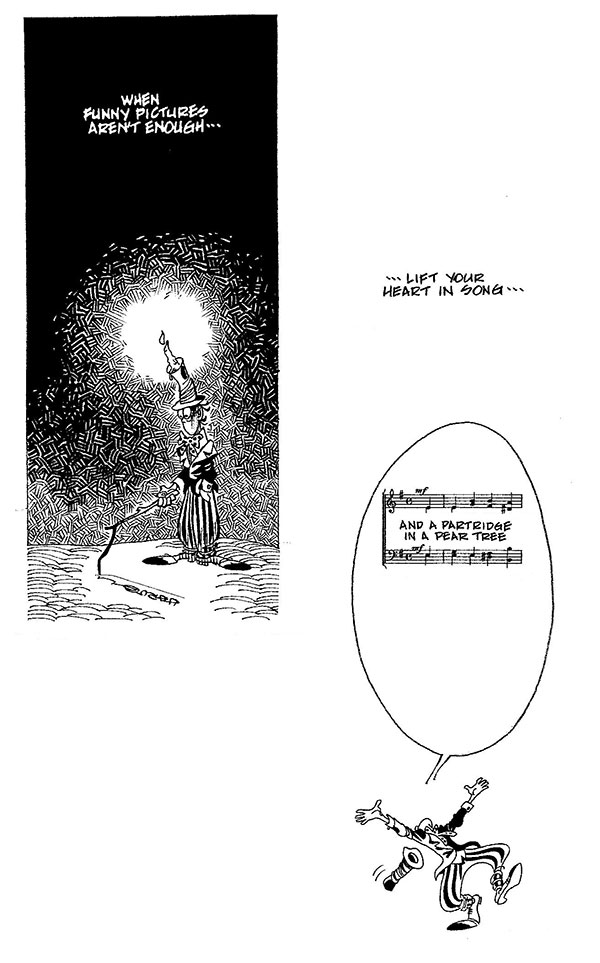
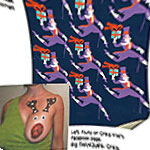

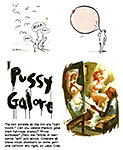
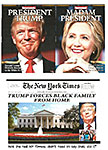
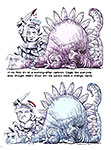
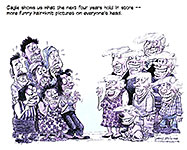
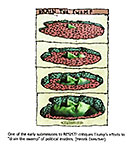
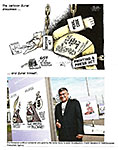
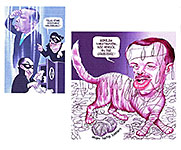
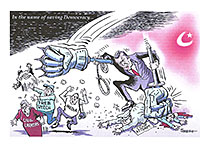
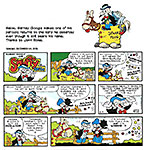
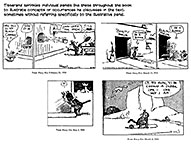
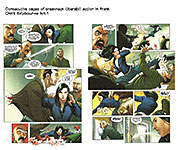
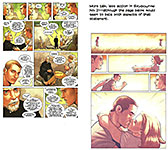
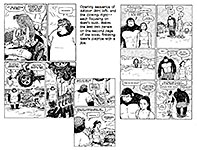
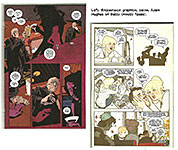
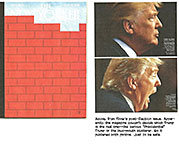
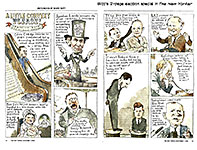
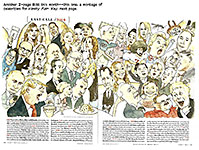
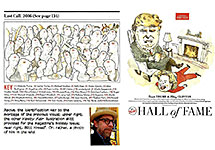
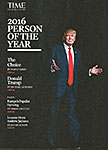
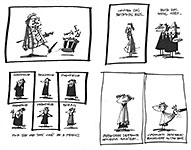
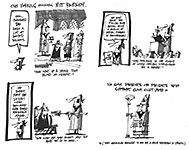
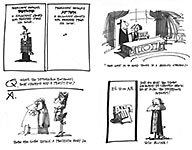
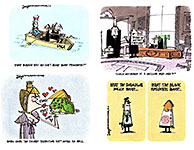
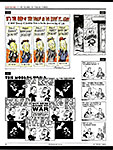
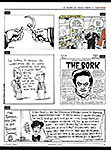

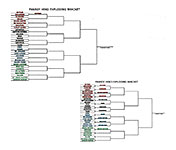
1.jpg)
2.jpg)
3.jpg)
4.jpg)
5.jpg)
6.jpg)
7.jpg)
